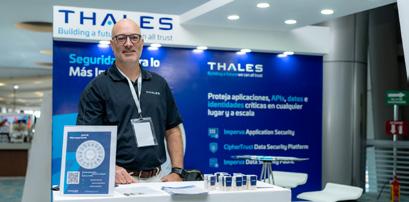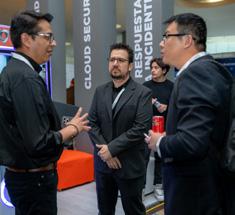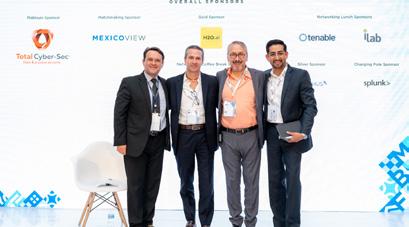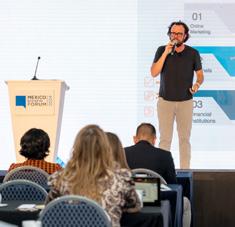IMPACT REPORT

OVERALL SPONSORS
Platinum Sponsor
Matchmaking Sponsor Gold Sponsor
Networking Lunch Sponsors
Silver Sponsors
Networking Coffee Break Sponsors
Charging Pole Sponsor


Platinum Sponsor
Matchmaking Sponsor Gold Sponsor
Networking Lunch Sponsors
Silver Sponsors
Networking Coffee Break Sponsors
Charging Pole Sponsor
Platinum Sponsor
Sponsors
Gold Sponsors
Sponsors
Sponsors
Sponsors
Sponsors
Silver Silver Gold Silver Silver424 companies
740 conference participants
140 speakers
1st Edition
Breakdown by job title Conference social media impact
30.4% Director/VP/ COO/CFO
27.8% Manager/Executive/ Associate
19.8% CEO/DG/President/ Country Manager
12.0% CISO/CTO/CIO
8.7% Founder/CoFounder
direct impressions during MBF
click through rate during MBF
conference engagement rate
mexico’s leading B2B conference organizer uses a customized app to deliver an unparalleled experience
the m B e app delivered aI-powered intent-based matchmaking to the mexico Business Summit 2023 attendees
M atchmaking
534 participants
3,740 matchmaking communications
728 1:1 meetings conducted
24 sponsors
16,690 visitors to the conference website
social media impact
direct pre-conference LinkedIn impressions
pre-conference click through rate
pre-conference engagement rate




Matchmaking intentions
Trading
Networking
• 500 Global
• 99minutos
• a& a Business Consulting
• a3Sec
• actinver
• addem Capital
• adistec
• adyen
• afluenta
• albaa
• alcon Laboratories
• alibaba Cloud
• alima
• almabrands
• aloi
• altair
• aM d
• american e xpress
• aM e XC aP
• ammper
• aMVo
• ancient - the Wisdom of technology
• angel Ventures
• apolloCom
• Árbitro operativo Medios de Pago
• arces.mx
• arcos dorados / Mcdonald’s
• arkangeles
• aro y Chaz
• aSaM eP
• a sociación de Internet MX
• a sociación Mexicana de data Centers (M e XdC)
• a straZeneca
• at&t
• atalait
• attom Capital
• auronix
• aVIS
• avon
• Bamba
• Ban Bajio
• Banbajío
• Banca Mifel
• Banco a zteca
• Banco Compartamos
• Banco de Crédito del Perú
• BanCoppel
• Banngu Mexico
• BaNo B raS
• Banorte
• Banxico
• Baubap
• Bayer
• Bayport
• BBVa
• BeClever
• Belvo
• Benotto
• Beyond technology
• BIC
• Birdie.mx
• Bitso
• Blooms
• BMC
• BNP Paribas
• Boletia
• Bolsa Institucional de Valores (BIVa)
• Bolsa Mexicana de Valores
• Bono
• Brain food
• Bright minds
• Broxel
• Buo
• Bvlgari
• C12
• Caja Inmaculada
• Cakao Studio
• CancunCards
• Capsula
• CapWatt
• Cecoban
• Cerveceria de Colima
• Chevez ruiz Zamarripa
• Cicada technology
• Cinépolis
• Circulo de Belleza
• Citibanamex
• Clara
• Clearsale
• Clip
• Closer
• Club de rotarios
• CMX Partnerships
• CNBV
• Cobee
• CodeCo
• Coldview
• Cometa
• Complif
• Concepto Móvil
• Conecta
• Conekta
• Connectif
• Consubanco
• Content-oh!
• Coppel
• Crabi
• Cracks education
• Cradlepoint
• Creai
• Creditas
• Crowdlink
• CyberIIot
• Cybersec
• CyCSaS
• data4Sales
• daWa
• debiti
• dell technologies
• deloitte
• delta Protect
• dentons Global advisors
• design banking
• deUNa
• dHL Global forwarding
• dIL a Capital
• dIN code
• directo
• dLocal
• doopla
• ebanx
• eGlobal
• el ojo en la Bola
• el Palacio de Hierro
• elektra
• embassy of Belgium
• embassy of Canada
• embassy of Switzerland
• endeavor
• energyrecharge!
• eNSo fintech
• envases Universales
• envíoclick
• e strategia MIC
• eteK
• eureka
• evolutive agency
• e xitus credit
• eyS equipo y Soluciones
• f5
• fairplay
• feedzai
• femsa
• feMSa Ventures
• financiera Contigo
• fintech Mexico
• fINto NIC
• finvero
• fiserv
• fitzer Hard Seltzer
• fJ Labs
• forma Pro LLC
• fortinet
• fraudection
• freedompay
• freSSI
• frIaLSa
• GBM
• Getin
• Global University Systems Canada
• Goliath Group
• Google Cloud
• Government of ontario
• Grupo Bal
• Grupo BIMBo
• Grupo BMV
• Grupo Coppel
• Grupo Cynthus
• Grupo envases
• Grupo IaMSa
• Grupo Jumex
• Grupo Samaredi
• GS1 México
• Guidance research
• Guros
• H2o.ai
• HaM oC
• Healf
• Hefesto a sesores
• Herdez
• Hermes Capital
• Hi Ventures
• Hikvision
• Holland House Mexico
• Homie
• Hooman
• Hootsuite
• Hospitales MaC
• Houlihan Lokey
• HSBC
• Hugo Boss
• Iberdrola
• IGNIa Partners
• iLab
• Imperva
• Indeplo
• Index
• Industrias de Hule Galgo
• Infomedia
• InfraCommerce
• Ingenico
• Ingredion
• Insurtech México
• Intelligent Networks
• Intrare
• Investplaybook
• IronVest
• Izzi
• JaaK
• Japan International Cooperation agency
• Jelou
• Juniper Networks
• Kalto
• Kapital
• Kaszek
• K ayaK
• Kinsu
• Klar
• Knotion
• Koin
• Konfío
• Kontempo
• Koval
• KPMG
• Kurios
• Kushki
• Kyndryl
• La Comer
• Lacoste
• Latin eMart
• Leapfinancial
• Legal Sync Consulting
• LegoSoft
• Lightech
• Linio
• Liverpool
• LKL Pay
• Lumen
• M2Crowd
• MaB e
• Mamafoods
• ManpowerGroup
• Maqui
• Mastercard Mexico
• Masu
• Matt-ambrose.com
• McKinsey
• Meda fintech
• Melonn
• Mendel
• Merama
• Mercado Libre
• Mercado Pago
• M eta
• Mexican Internet a ssociation
• Mezubo
• Michelin Connected fleet
• Microsoft Corporation
• Miniso
• Minsait Payments
• Minu
• Miramar Capital
• Misumi México
• Mo Credit Management Platform
• Monai
• Mondelez
• Moova
• Mora Mora
• Mundo Mondo
• Naesco
• Nativa tulum
• Natura & avon
• Nazca
• N eK t
• N eK t Group
• Netrum-SIta
• Nido Ventures
• Novax
• Now By Invex
• Nu
• Nvio Pagos
• Ny U Stern School of Business
• odeSSa
• o ffice depot México y Centroamérica
• o fficeMax Mexico
• okticket
• oneCarNow
• openfinance
• openPass
• PagaPhone SmartPay
• Palenca
• PaLo It
• Payretailers
• Pedrote
• Peñaranda
• Peñoles
• Pérez Correa González
• Pilou
• Pixza
• Planet Halo Security
• Plata
• Plenna
• Pontones y Ledesma
• Prestadero
• Productos Chata
• Proofpoint
• ProSa
• Provident
• Provident Mexico
• Pulpo
• Q ed Investors
• Qualitas
• r 2
• rankmi
• rappi
• rappiCard
• regus
• reservamos SaaS
• reversso
• revie
• rich it
• rintin
• routefusion
• rU fI
• runa
• Samsonite
• Samsung electronics
• Scotiabank
• Sekura
• Shake again
• SH eIN
• Shell & Quaker State
• Sherwin Williams
• Silent4Business
• Simpliroute
• Sisley
• SkillNet
• SoftBank
• Solu
• Speakap
• Splunk
• Storecheck
• Stori
• StP
• Stragia
• Surexs
• Surrey Board of trade
• Surtidora departamental
• Swarovski
• Swatch Group Mexico
• t 7 International Group
• tec de Monterrey
• technisoft
• techsinergy
• telecable
• telecom televisa Univision
• tenable
• texas european Chamber of Commerce
• thales Group
• the 1% of finacial Leaders
• the Body Shop
• the e stée Lauder Companies México
• this Week in fintech
• thomson reuters
• tienda Pago
• tiendanube
• tM f Group
• toSSa
• total Cyber-Sec
• towa software
• tricia Consulting
• troquer
• trully
• truora
• tu Identidad
• t V a zteca
• Ualá
• UNaM Semillero de talento
• Undostres
• Unilever
• Universidad Panamericana
• UPa X
• VegaPay
• Vertebra
• Ve XI
• Vezmé
• Vfo Mexico
• Vinneren
• VISa
• Voximplant
• Walmart Mexico
• WebCX
• Weber Shandwick
• Weinen 2000
• Weiner Lab
• Whirpool
• Wiener Lab
• Wow factor Pr
• W tS energy
• X design
• Xaldigital
• X aPIeNS
• Xepelin
• yaax Capital
• yalo
• yave
• yofio
• Zebras
• Zenda.la
• Zendesk
• Zumit tech
WEDNESDAY , APRIL 24
09:00 TECH FOR ALL AGES: INTEGRATING ELDERS INTO MODERN FINANCE
Speaker: Aurora Torres, CNBV
09:30 CYBERDOME, THE ANTI-RANSOMWARE STRATEGY
Speaker: Francisco Sandoval, total Cyber-Sec
10:00 AI: REVOLUTIONARY MILESTONE IN CONNECTION GENERATION
Speaker: Marco Casarin, Meta
10:30 DISRUPTING THE NORM: FINTECH’S ROLE IN BUSINESS MODERNIZATION
Speaker: Adolfo Babatz, Clip
12:00 FINTECH REVOLUTION IN MEXICO: REDEFINING CONSUMER EXPECTATIONS
Moderator: Othón Moreno, BaNXICo
Panelists: Neri Tollardo, Plata
Luis Pineda, Now by INVe X Banco
Stefan Moller, Klar
Iván Canales, Nu Mexico
12:45 MEXICO’S FINANCIAL LANDSCAPE: FISERV’S VISION FOR FUTURE-READY SOLUTIONS
Speaker: Luis Brauer, fiserv
13:15 THE EVOLUTION OF CUSTOMER PERSONALIZATION IN FINANCE THROUGH AI
Moderator: Sergio Torres, BBVa
Panelists: Ximena Salgado, Nu Mexico
Louis Zaltzman, rappiCard
Joaquín Domínguez, Ualá
Santiago Benvenuto, Walmart Mexico and Central america
STAGE A3
12:00 CONNECTING THE DOTS: MAPPING CONSUMER JOURNEYS
Moderator: Miguel Ángel Ruiz, Kyndryl
Panelists: Carlos Marín, Liverpool
Anastasia Zdoroviak, rappi
Alejandro Caballero, Mercado Libre México
12:45 RETAIL STRATEGY 3.0: THE NEW ROLE OF BRICK & MORTAR
Speaker: Sofía Escamilla, the Body Shop
13:15 CUSTOMER PATHWAYS WITH AI-POWERED PERSONALIZATION
Moderator: Martín Ascar, H2o.ai
Panelists: Albert González, Samsung
Juan José Piñeiro, el Palacio de Hierro
Marco Gelosi, Swarovski
Juan Vallejo, Google Mexico
STAGE A2
12:00 SURVIVING THE DIGITAL REALM: CYBERSECURITY FOR SMES AND STARTUPS
Moderator: Víctor Lima, Undostres
Panelists: Paolo Rizzi, Minu
Omar Herrera, Stori
Andrew Devlyn, fairplay
Enrique Besa, rankmi
12:45 QUANTIFY CYBER RISK AND OPTIMIZE CYBERSECURITY INVESTMENTS
Speaker: Juan Carlos Cortés, Netrum-SIta
13:15 SECURITY SIMPLIFIED: STRATEGIES FOR A LEANER, SAFER TECHNOLOGY STACK
Moderator: Santiago Fuentes, delta Protect
Panelists: Rafael Verduzco, Zenda.la
Erik Johannessen, Xepelin
Federico Cedillo, financiera Contigo
13:45 WHERE BAD IDEAS FIND LOVE
Speaker: Víctor Moctezuma, iLab
STAGE A4
15:30 FUTURE-PROOFING E-COMMERCE: OMNI-CHANNEL, PERSONALIZATION, AND CONVERSIONS
Moderator: Omar Pérez, Splunk
Panelists: Rolando López, o fficeMax Mexico
Edgar Embriz, Swatch Group Mexico
Fabricio Moreno, adyen
16:15 LEVERAGING REVERSE LOGISTICS IN ECOMMERCE FOR A SUSTAINABLE GROWTH
Speaker: Javier Dolcet, dawa
16:45 NAVIGATING THE BLEND OF BRICK-AND-MORTAR AND DIGITAL FRONTIERS
Moderator: Cristian Campos, Samsonite
Panelists: Marco Di Santo, Bvlgari
Laura Torres, Hugo Boss
STAGE A3
15:30 SYSTEMIC VULNERABILITIES IN INTERCONNECTED FINANCIAL NETWORKS
Moderator: Santiago Gutiérrez, deloitte Mexico and Latam
Panelists: Francisco García, BNP Paribas
Eduardo Amaya, Grupo Cynthus
Roman Baudrit, thales Group
16:15 HOW TO USE IA FOR LEVERAGING THE BUSINESS
Speaker: Pablo Corona, Mexican Internet association
16:45 INCIDENT RESPONSE MASTERY: PROTECTING CRITICAL SERVICES
Moderator: Claudio Querol, McKinsey & Company
Panelists: Arturo Rivera, Banca Mifel
Rafael Chávez, f5
STAGE A2
15:30 EMPOWERING AI AND CLOUD: LATIN AMERICAN ENTREPRENEURS COMPETING IN A GLOBAL ARENA
Moderator: Christine Kenna, IGNIa Partners
Panelists: Courtney McColgan, runa H r
Luis Barrios, arkangeles
Javier Mata, yalo
Maite Muñiz, truora
16:15 AI FOR ALL: EMPOWERING WOMEN IN THE AGE OF INNOVATION
Speaker: Anaid Sustaita, Google Cloud México
16:45 AI-POWERED VENTURES: TRANSFORMING THE STARTUP LANDSCAPE AND VC FUNDING CRITERIA
Moderator: María Fernanda González, Hi Ventures
Panelists: Rafa de Haro, Cometa VC
Antonia Rojas, attom Capital
Alejandro Diez, dIL a Capital
Juan Franck, SoftBank
THURSDAY , APRIL 25
STAGE A4
09:00 PREDICTIVE ANALYTICS STRATEGIES FOR MARKET DISRUPTION
Moderator: Jorge Mandujano, Beyond technology
Panelists: Gabriel Fernández, at&t México
Dario García, ManpowerGroup L ata M
Diego Sánchez, Mabe
09:45 AI: IMPORTANCE, ADOPTION & FUTURE
Speaker: Francisco Aguirre, dell technologies
10:15 MASTERING DATA MONETIZATION FOR BUSINESS GROWTH
Moderator: Ignacio Madrid, Citibanamex
Panelists: Iván González, Grupo Jumex
Juan José Denis, BMC Mexico
Denis Génova, Xaldigital
Alejandro Correa, aBInBev-Grupo Modelo
STAGE A3
09:00 THE FINTECH FRONTIER IN MEXICO: NAVIGATING THE NEW LANDSCAPE OF COMPETITION
Moderator: Pamela Ceballos, VISa Mexico
Panelists: Vincent Speranza, endeavor Mexico
Gabriela Estrada, Vexi
Héctor Cárdenas, Conekta
Gerardo Obregón, Prestadero
09:45 THE KEYS TO PROFITABILITY: DIGITALIZATION OF FINANCIAL PROCESSES
Speaker: Luis López Albajara, o K tICKet México
10:00 CLOSING THE FINANCING GAP
Speaker: Mónica Ajarrista, addem Capital
10:15 CREDIT IN MEXICO: THE RACE TO STAY AHEAD
Moderator: Alberto Bonetti, yofio
Panelists: René Saúl, Kapital
Manolo Atala, fairplay
Gabriela Rolón, Creditas
Leonardo Ramos, Clara
STAGE A2
09:00 TECHNOLOGY CHALLENGES OF HYPERCONNECTING COMMERCE
Moderator: Julia Urbina-Pineda, o ffice depot
Panelists: Adrian Valencia, at&t México
Edmundo Lozano, Whirlpool
Raúl Cornejo, elektra
09:45 TIPPING THE SCALES IN OUR FAVOR
Speaker: Rene Aguero, Splunk
12:00 RISK-BASED VULNERABILITY MANAGEMENT: PRIORITIZING RESILENCE
Moderator: Juan Carlos Carrillo, tenable
Panelists: Enrico Belmonte, Peñaranda
Óscar Caballero, KPMG Mexico
Erwin Campos, Grupo Bimbo
Eduardo Salmerón, Silent4 Business
12:45 START YOUR JOURNEY TO PROACTIVE CYBERSECURITY
Speaker: Praveen Sengar, eteK
13:15 THIRD-PARTY CYBERSECURITY RISK ASSESSMENTS AND NEGOTIATION
Moderator: Marco Antonio Castilla, aVIS Mexico
Panelists: Felipe Absalon, Bayer
Mauricio Amaro, Grupo IaMSa
Jenny Mercado, odeSSa
12:00 E-COMMERCE RENAISSANCE: LATIN AMERICAN STARTUPS AND THE VC IMPERATIVE
Moderator: Mariano Bomaggio, Kaszek
Panelists: Ytzia Belausteguigoitia, troquer
Quinto Van Peborgh, rintin
Felipe Delgado, Merama
Héctor Sepúlveda, Nazca
12:45 FROM POTENTIAL TO POWERHOUSE, MERAMA: RETAIL & ECOMMERCE GROWTH IN LATAM
Speaker: Domingo Cruzat, Merama
13:15 FORMULATING SUCCESS IN OMNICHANNEL COMMERCE
Moderator: Lorena Montaño, Mundo Mondo
Panelists: Alejandro García, Miniso
Daniel Navas, Mora Mora
Alexis Patjane, 99 minutos
Carolina Arreola, Zendesk
STAGE A2
12:00 TECH-DRIVEN FINANCE: NAVIGATING TRANSFORMATION IN LATIN AMERICA
Moderator: Ana Cristina Gadala-Maria, Q ed Investors
Panelists: Myriam Cosío, Clip
Jorge Cabrera, Mercado Pago
Alejandro Servín, BBVa
Ana Carolina Blanco, BanBajío
12:45 ECONOMY AND PROFITABILITY WITH GENERATIVE ARTIFICIAL INTELLIGENCE
Speaker: Martín Ascar, H2o.ai
Favio Vázquez, H2o.ai
13:15 AI IN B2B FINANCIAL SERVICES: TRANSFORMING THE INSTITUTIONAL CUSTOMER EXPERIENCE
Moderator: Patricio Diez, Banco Compartamos
Panelists: Juan Manuel Andrade, Banco a zteca
Jorge González, actinver
Armando Herrera, Konfío
Daniel Garbuglio, H2o.ai
STAGE A4
15:30 NAVIGATING MEXICO’S VENTURE CAPITAL: TRENDS AND INSIGHTS
Speaker: Liliana Reyes, aM e XC aP
13:15 LATAM STARTUPS’ QUEST FOR INVESTMENT
Moderator: Alvaro Vértiz, dentons Global advisors
Panelists: Ana Carolina Mexia, Nido Ventures
Cecilia Ezquerro, 500 Global
Andrea de la Garza, Pilou
Constantino Matouk, Grupo Bimbo
STAGE A3
15:30 PROTECTING THE CLOUD: CNAPP AND IDENTITY MANAGEMENT FOR THE EXTENDED ATTACK SURFACE
Speaker: Alejandro Dutto, tenable
16:00 AI-OFFENSIVE: THREAT HUNTING IN THE CLOUD
Moderator: David Varela, Izzi
Panelists: Asgard León, t V a zteca
Chava Valades, a straZeneca
Jonny López, Cradlepoint
Eduardo Verboonen, Hospitales MaC
STAGE A2
16:00 NEW PAYMENT PARADIGMS: EVOLVING TRANSACTIONS
Moderator: José Barrera, Natura & avon
Panelists: Sebastián De Lara, fintech Mexico
Héctor Meza, Ingenico
Analicia García, Mastercard Mexico
Estephany Ley, Coppel
With an estimated 16.4 million adults aged 60 and above projected by 2024, constituting 12% of the total population, addressing the challenges faced by this demographic is imperative. a significant challenge highlighted by a urora torres, d irector General of a uthorizations for the f inancial System, CNBV, is the digital divide affecting older adults’ access to and utilization of technology, especially in financial contexts. Issues like lack of familiarity, debt aversion, anxiety, and disinterest impede older adults’ technology adoption. addressing the challenges faced by older adults in adopting technology, especially in financial contexts, is crucial, urges torres.
In Mexico, the demographic landscape is evolving, with 13.5 million individuals aged 60 and above, as reported by the National Population Council (C o N a P o). factors such as declining mortality rates and increased life expectancy contribute to this demographic shift, with further increases expected by 2030.

elderly individuals in Mexico benefit from robust regulatory measures, as explained by torres. She highlights one of the fundamental rights enshrined in the constitution, which is access to employment and the economy for senior citizens. However, various societal factors contribute to a technology access gap for older individuals. additionally, across different regions of Mexico, there is limited access to financial institutions. only 8.2% of Mexican users making digital payments fall
within the 55 to 64 age bracket, according to Ve Por Mas.
f inancial institutions are increasingly transitioning to technological platforms, which may pose challenges for elderly individuals, making the financial system less accessible and user-friendly for them. “While technology is often associated with youth, it is important to recognize that older adults will also utilize this technology,” she emphasizes.
torres urges decision-makers to deploy user-friendly strategies directed toward senior citizens as it is a matter of inclusion. t his goes in line with avoiding an oftenoverlooked type of violence older people face: economical and financial violence. She highlights the role of the National Institute of o lder adults (IN a Pa M) as an institution that advocates for inclusion and the development of the elderly. Nonetheless, the support from financial institutions to actively bridge this gap is essential, she says.
torres believes that there are opportunities to narrow this gap by sensitizing technology developers to the unique challenges faced by older adults and designing user-friendly interfaces, incorporating features like larger fonts, visual cues, and voice assistance. “Inperson support at bank branches should prioritize empathy and patience, with staff trained to effectively assist older adults, including offering alternatives to fingerprint authentication.”
In the financial sector, there are specific opportunities to enhance accessibility for older adults, according to CNBV. f or example, at Ms can provide clear instructions and prompts, accompanied by alerts signaling transaction completion. Mobile apps can offer simple instructions and assistance, while in-person support at bank branches should prioritize empathy and patience, with staff trained to effectively assist older adults, including
offering alternatives to fingerprint authentication. Collaboration between decision-makers, regulatory bodies, and
financial institutions is vital to bridge the technology gap and ensure financial inclusion for older adults, adds torres.
r ansomware attacks pose a significant threat to businesses worldwide, with the average financial impact of a data breach reaching US$4.54 million, as per IBM’s “Cost of a data Breach 2022” report. these attacks have far-reaching consequences for business operations, reputation, finances, and legal standing. francisco Sandoval, d irector General of total Cyber-Sec, underscores the necessity for proactive and comprehensive solutions to address this threatening landscape.
Given the extensive ramifications of a successful attack, total Cyber-Sec has introduced Cyber d ome 360°, a comprehensive cybersecurity solution designed to effectively counter ransomware attacks and shield businesses from their adverse effects. By employing a multilayered approach that integrates various technologies and services, total CyberSec aims to provide comprehensive protection against ransomware and other cyber threats. “Israel’s Iron d ome has a 90% effectiveness. However, it only covers air menacing attacks, not land or sea; a multilayered system is essential, not only in physical security, but also in cybersecurity,” Sandoval added, referring to the recent Iranian air attacks on Israel.
Sandoval said the prevalence of ransomware attacks underscores the pressing need for robust cybersecurity measures, as
cybercrime is now massified, targeting even smaller companies. “ t here are two types of attacks, targeted and opportunistic. the latter comes as criminal organizations seek to massify attacks, ensuring the monetization of ransom payments,” Sandoval noted.
With organizations increasingly dependent on interconnected systems and data-driven operations, the risk of disruptive cyber incidents continues to grow. Solutions like Cyber d ome 360°, not only address immediate threats but also contribute to strengthening the resilience of businesses against evolving cyber risks, says Sandoval. a s businesses embrace digital transformation and expand their online presence, the importance of investing in comprehensive cybersecurity solutions cannot be overstated.
Sandoval highlighted the different layers of Cyberdome 360° and how they contribute to the complete protection of organizations.
t his layer focuses on the identification and assessment of an organization’s critical assets, including sensitive data, key systems, and vital resources, allowing the identification of vulnerabilities and weaknesses that could be exploited by attackers. t he solutions included in this layer, such as e ndpoint Management,

r isk and Compliance, and Identity Perspective Guidance, help to effectively manage and protect these critical assets. Sandoval emphasized the importance of regularly updating gadgets and apps, highlighting that hackers’ technology constantly evolves.
t his layer focuses on educating users about safe cybersecurity practices, as well as implementing detection and response solutions on devices to identify and neutralize threats before they cause harm. “How can we communicate to the administration, support, and marketing departments the importance of being cautious when clicking on emails? We need to educate them based on their profiles, in a friendly manner to ensure good understanding,” Sandoval noted.
Privilege escalation is a technique commonly used by attackers to gain unauthorized access to sensitive systems and data. this layer focuses on logging and monitoring the activities of privileged users, as well as implementing multi-factor authentication measures to ensure that only authorized individuals can access critical resources. f eatured solutions in this layer include privileged user management and multifactor authentication.
Critical servers are prime targets for ransomware attacks due to their importance in an organization’s infrastructure. this layer focuses on implementing micro-segmentation techniques to isolate and protect servers, as well as implementing edr for servers, operating system hardening, and intrusion prevention systems. Sandoval noted that intrusion prevention systems are crucial since all internet threats present behavior patterns. recognizing and understanding these behavior patterns is crucial for any
organization’s survival. He underscored the growing significance of artificial intelligence in identifying these patterns to detect threats from viruses, malware, individuals, or other risk factors.
a s early threat detection is crucial to mitigating the impacts of an attack, this layer focuses on implementing services and solutions that actively monitor the network for indicators of compromise and patterns of malicious behavior. advanced technologies such as artificial intelligence sensors, traps, and continuous monitoring of the Security o perations Center (S o C) are used to quickly detect and respond to emerging threats. In addition, a highly trained incident response team is in place to effectively manage and mitigate attacks. Key solutions in this layer include aI sensors, traps, S o C monitoring, incident response teams, and threat simulation.
Immutable backups are the last line of defense against ransomware, enabling data recovery in the event of a successful attack. this is why the last layer focuses on implementing robust backup and recovery processes that protect the integrity and availability of the organization’s critical data through technologies and practices that ensure the invulnerability of backups to tampering or deletion attempts by attackers.
r ansomware attacks are expected to continue to evolve in complexity and sophistication. However, Sandoval said that with solutions such as total CyberSec’s Cyberdome, enterprises can be better prepared to meet these ongoing challenges and protect against growing cyber threats. “No strategy guarantees 100% effectiveness; human error and evolving technology are constant challenges. Preparation is key, having a tested backup strategy and recovery processes is essential, highlighted by the need for simulations,” Sandoval concluded.
aI is experiencing unprecedented growth, with North a merica leading the charge as the epicenter of innovation and investment. While the technology promises boundless opportunities and transformative advances across various sectors worldwide, its potential to foster human connection can be equally large.
Meta, formerly known as facebook, has been a pivotal player in shaping meaningful connections, allowing 3.8 billion people worldwide to interact, says Marco Casarin, Country Manager Mexico, Meta. “Still, there are 4 billion people left who need the same opportunities to integrate. It is a huge responsibility,” he says.
t hrough the integration of a I across its platforms, Meta is revolutionizing the way individuals and brands connect and grow together, marking a significant milestone in the evolution of social media and digital interaction

“It is about providing an experience that is significant to the user. The key is to understand how to make it meaningful, and that requires analytics and ultra-human volumes of data capacity, transforming it into information, and turning that information into relevant, timely, and high-impact action.”
Marco Casarin Country Manager Mexico | Metait closer to companies of all sizes, not just those with the largest marketing budgets.
“Meta’s solutions ecosystem is a platform geared toward entrepreneurs and SMes. It is the same platform, opportunity, challenge, and tool for SM e s and big enterprises. It puts any idea, project, or scenario on the same level of competitiveness, exposure, generating meaningful connections, and succeeding,” says Casarin.
Meta’s suite of tools, known as Meta a dvantage, empowers advertisers with automation capabilities, leading to a 32% increase in r eturn on a d Spend ( roa S) for advantage shopping campaigns, a 9% improvement in cost per action, and a 14% boost in incremental purchases per dollar spent, says Casarin. the aI Sandbox further enhances creative endeavors by generating text variations, creating backgrounds, and adjusting images, saving advertisers more than five hours per week on average.
Meta Business Messaging has also yielded remarkable results, with a 61% average increase in lead generation compared to traditional solutions, says Casarin. Conversion rates soar with Meta Business Messaging, surpassing 53% for SMS, 61% for email, and a staggering 87% for other apps. Businesses also witness a 22% increase in order value, a 54% improvement in agent productivity, and a significant uptick in customer retention rates.
Meta leverages its a I-powered engine for discovery, security, and integrity efforts.
“a I has allowed us for over a decade to continuously optimize the way people find and connect with what is relevant to them,” says Casarin. Meta now offers virtual reality (V r ), conversational commerce, and advertising systems. Integrating a I is not merely a technological feat; it is a game-changer in optimizing campaign performance and user experience, he adds. By incorporating this tool, Meta is putting
“Meta invested in a I to empower users throughout the complete path, from someone discovering something they consider could lead to a meaningful connection, to generating some type of transaction, and from there, building a community,” says Casarin.
Meta’s impact extends beyond demand generation; it facilitates conversions across the entire customer journey. Meta’s full-funnel solutions are increasingly being adopted by the market, with 58% of consumers affirming
Meta as the go-to platform for building brand relationships, 46% crediting Meta’s technology for facilitating purchases, and 70% discovering new products or brands through Meta’s technologies. a bout 1 billion people engage with businesses via Messenger, Instagram, and Whatsapp every week, highlighting the reach and influence of Meta’s platforms. Casarin also underscores its commitment to inclusivity with language translation capabilities that encompass over 1,100 languages.
“We seek to connect people, who have ideas and experiences that are enriched
through others, and that is our mission: to connect people in a meaningful way, and to do it increasingly better. t hat is why we invest in a I,” says Casarin.
the market for aI is growing exponentially, with North a merica boasting the largest market size globally, according to the a I r PM. t he United States commands an estimated market size between US$87.18 billion and US$167.3 billion. Projections suggest that by 2032, the global a I market could surpass US$2.5 trillion, driven by a compound annual growth rate (C aG r) of 19%.
Clip, a prominent provider of commerce solutions for micro, small, and mediumsized merchants in Mexico, attributes its success to four core pillars, according to C eo adolfo Babatz at the Mexico Business forum 2024.
f irstly, the company’s end-to-end commerce platform offers intuitive, modern solutions tailored to empower merchants. Secondly, its unique go-to-market model enables rapid and cost-effective expansion across Mexico. t hirdly, Clip prioritizes delivering a seamless and efficient customer experience. Lastly, its distinctive culture fosters continuous innovation, ensuring sustained growth and relevance in the competitive market landscape.
Clip’s market strategy, which emphasizes a robust distribution network and strong brand loyalty, has fueled its rapid expansion throughout Mexico.

“It is about solving a very simple problem that has become very complicated”
Adolfo Babatz CEO | Clip
despite initial financial challenges, Clip has demonstrated its ability to scale rapidly, employing a blitzscaling strategy. “ the very first fundraising check Clip received, when it was still called iPay, was for US$50,000,” Babatz recalls. “Money is necessary because you need to scale.”
Subsequent successful fundraisings reflected the company’s commitment to blitzscaling, reaching a milestone in Mexico’s history with a $1.5 million acquisition in its first round of financing in 2013.
Clip’s dedication to innovation is evident in its focus on transaction security, as highlighted by Babatz: “at that time, we had a serious problem with card cloning, we spent a lot of money on designing the hardware to make it safe.”
as the company has grown, it has surpassed traditional banks in customer acquisition and registered transactions. “In 2018, we surpassed all banks in Mexico in terms of registered merchants and transactions,” Babatz emphasized.
this exponential growth has been driven by a world-class team dedicated to the company’s vision and culture. “ t he company’s management team is a world-class team,
formed by people from all over the world who have very diverse experiences,” noted Babatz.
Looking ahead, Clip remains steadfast in its mission to simplify payments for all,
from small businesses to large enterprises.
“What we wanted to do is extremely simple: ensure that any business or person could accept any payment method in one place,” Babatz concluded.
t he landscape of financial services in Mexico is undergoing a seismic shift, driven by the rapid rise of fintech companies.
t hese innovative startups are not only redefining traditional banking norms but are also reshaping consumer expectations, particularly among the youth and unbanked population. a s the fintech revolution gathers momentum, traditional banks find themselves in a fierce competition to adapt and cater to the evolving demands of consumers.
younger demographics, in particular, are gravitating towards fintech solutions for their convenience, accessibility, and tailored services. o thón Moreno, d irector of Payments Systems and Market Infrastructure Policy and research, Banxico, highlights how, just as fintech companies and SofIPos came to change the landscape of finance in Mexico, now it is the clients who are beginning to dictate new trends.
“It is no longer the same to serve a 60-yearold man as it is to serve a 17-year-old girl. the way they understand financial services is fundamentally different in terms of immediacy and privacy.”

Iván Canales, director General, Nu México, identifies that the client in Mexico has learned to have better digital products and have access to global services, also leading them to demand better customer service.
“Historically in Mexico, banking institutions have been characterized by being difficult to navigate. Now, the user has access to more tools and consequently demands better attention.”
In response to this changing landscape, traditional banks are partnering or acquiring fintech companies, allowing banks to leverage the agility and innovation of startups while retaining their expertise and infrastructure. By integrating fintech solutions into their service offerings, banks can cater to a broader range of consumer needs and stay competitive in the evolving market.
Neri tollardo, C eo , Plata, points out that “curiously”, new generations have largely been the driving force behind the emergence of platforms such as fintechs, since “consumer expectations regarding their banks have driven innovation.”
tollardo highlights three main ways in which traditional financial institutions have had to respond to new user expectations. f irst, banks have improved the quality of their products with digital services. Second, they have had to add value because it has never been easier for clients to migrate between financial services. finally, the culture of the financial sector has changed in terms of the paperwork process due to the immediacy that the client expects.
f intech companies have employed various strategies to capture the younger

demographic in Mexico. By offering gamified experiences, personalized financial management tools, and social media integration, fintechs have created engaging platforms that resonate with the digital-native generation. additionally, the use of data analytics and aI-driven insights enables fintechs to offer targeted products and services that cater to the specific preferences and needs of young consumers.
However, Luis Pineda, C eo , Now by Invex, recognizes that much of the boom in the adoption of fintech was due to the pandemic. But thanks to the adoption of digital solutions, clients are now not willing to endure traditional processes. Pineda explains that the revolution in the adoption of fintechs has occurred in three main stages. first, the landscape changed with the arrival of these new digital players. then, the client has become an educated and banked consumer. t hird, fintechs and S of IP o S now must evolve because being first in the game is no longer enough to continue being competitive. “We owe the market more sophisticated mechanisms,” he adds.
to effectively compete for this crucial market segment, traditional banks must embrace a similar mindset of innovation and customer-centricity. By leveraging their brand reputation and extensive customer base, banks can introduce innovative digital solutions and personalized experiences that appeal to the younger demographic.
d espite the focus on the customer and their experience, fintechs must also take into account their cost schemes and how the implementation of these innovative strategies affects them. Stefan Moller, C eo , Klar, explains that competitiveness also lies in the cost structure and its comparability with other players within the sector. Moller highlights the importance of understanding that, as part of the digital d N a of fintechs and S of IP o S, their cost structure should be seen as that of digital or software companies, rather than traditional financial entities. t his implies that digital financial services companies have a great advantage, since when considered as software companies, costs per user tend to be minimal. a lthough this makes the sector competitive, Moller recognizes that traditional financial companies still have the capacity to continue developing their presence in digital services, anticipating greater competition on their part.
While the fintech revolution presents immense opportunities, it also brings regulatory challenges that impact the transformation of the Mexican financial landscape. e xperts agree that regulation is a large part of the success of financial institutions, whether traditional or digital. t hey anticipate that users will continue to be more demanding in terms of security and data protection, and will continue to be demanding in terms of intuitiveness and ease of use of the services. While the costs of opening and maintaining clients remain competitive for fitechs, banking entities have a great capacity to catch up in this competitive environment. f urthermore, a crucial issue regarding customer expectations will be the expectation of remuneration for keeping money in accounts, a gamechanger for the industry that increases competitiveness even more.
despite the advances made in recent years, a significant portion of Mexico’s population
remains excluded from formal financial services, with 53% of adults lacking bank
accounts as of 2021, according to the National Baking and Stock Commission (CNBV). a mid these challenges lies an opportunity fueled by the emergence of fintech platforms.
t he Mexican financial landscape is undergoing a transformation driven by the convergence of fintech innovation and traditional financial institutions. the CNBV reports that fintech platforms are driving a 32% increase in the adoption of digital financial products, presenting a promising pathway toward broader financial access. Cutting-edge technology will play a key role in fostering financial inclusion and enhancing consumer experiences, says Luis Brauer, d irector of Business d evelopment and Strategy, fiserv.
With seven out of every ten people lacking access to credit and over half of the population without a bank account, according to CNBV, the adoption of electronic money becomes imperative to drive up transaction volume. the emergence of aggregators, players, and comparators has accelerated financial inclusion, making services more accessible and relevant to an increasingly active population. However, open banking regulation will be key in fueling financial digitalization, says Brauer.
according to a study made by the fintech a ssociation of Mexico, three key verticals drove the evolution of fintech and financial

institutions in 2022, explains Brauer. t he first, “ fintech as a Service,” pertains to the essential infrastructure and digitalization solutions for financial entities. t he next is the “ digital Payments” vertical, facilitating seamless money transfers and transaction processing across digital platforms. finally, the “Lending” vertical leverages online platforms to streamline credit access for individuals and businesses, catalyzing economic growth and entrepreneurship.
the fintech association of Mexico surveyed 700 fintechs and found that between 13.4% and 17.6% of their growth in clients and market share came through strategies focusing on operational agility, profitability, and data analytics.
“ d ata analytics empowers and enables hyper-personalization. What a fintech company is seeking, in addition to profitability, is to provide experiences that differentiate how to reach a market. Moreover, customers are becoming increasingly demanding, requiring that such experiences be accompanied by agility and precision,” says Brauer.
User experience is of paramount importance in shaping strategic initiatives within fintech, says Brauer. from seamless digital interactions to personalized services, consumers demand agility, reliability, and innovation in their financial engagements. fiserv leads the charge in global processing and core banking solutions, says Brauer, delivering unparalleled reliability and efficiency.
t hrough signature offerings like the f irstVision platform, f iserv enables endto-end management of payment products, bolstered by real-time data analytics and adaptive a I models. a ligning with these expectations, fiserv champions a customercentric approach, epitomized by its cuttingedge firstVision International Payments-asa-Service Platform. this platform currently handles over 200 million transactions in Mexico, and is available in 33 countries worldwide.
Cloud banking solutions also play a pivotal role in driving operational agility and customer-centricity. f iserv’s Signature Next International Cloud Banking Solution thus emerges as a game-changer, says Brauer, offering a modern technology stack equipped with re S t ful a PIs and microservices. With seamless integration across public, private, hybrid, or multi-cloud environments, f iserv empowers financial institutions to deliver unparalleled digital experiences tailored to modern consumer expectations, he adds.
“In the technological and financial ecosystem we find ourselves in, agility is key, finance needs to be embedded,
and openness should prevail. t his fully cloud-based core banking ecosystem represents over 37 years of evolution since f iserv began its services in Latin a merica. We are very proud to present for the first time the evolution of this platform because it signifies the evolution of the digital bank into a completely new stack. e verything is already supported as processing as a service through a mechanism that, being fully native to the cloud, will allow a fintech, financial entity, or bank to offer differentiated values by embedding finance and services focused on investment and loans of all kinds to integrate with any processing platform,” says Brauer.
t he finance industry is undergoing a profound transformation in its approach to customer personalization. at the forefront of this revolution is the integration of artificial intelligence ( a I) technologies, enabling finance companies to deliver tailored experiences that resonate with individual needs and preferences.
finance companies are increasingly harnessing the power of aI to personalize the customer experience across various touchpoints. By analyzing vast amounts of data, including transaction history, browsing behavior, and demographic information, aI algorithms can generate insights into individual preferences, financial goals, and risk tolerance levels. this allows companies to deliver targeted recommendations, personalized product offerings, and customized communication channels, thereby enhancing customer engagement and satisfaction.
Nonetheless, a I is not new to the sector, affirms Ximena Salgado, Head of Product, Nu. Salgado explains how Nu has leveraged this technology to gain competitiveness in a sector that used to be very traditional and hard to access. She explains that Nu has used a I to accelerate the process of customer learning to help them access the
market. “a I has been used for decades, it helped greatly at the very beginning when we were not known to cater to a wide variety of clients through aI models that allowed for credit granting.”
Mexico Business forume xperts agree on aI uses to customize their product and services offering to clients. to fully embrace a I capabilities, Louis Zaltzman, Chief Growth o fficer, r appiCard, recommends seeing a I as a whole, integral system and deeply understand what are the problems it seeks to solve. Zaltzman explains that aI can help to adapt to each client. “Before deploying these systems we must truly understand the whole journey you need it to solve. It is not solely about having the best data set or having the most advanced process, but rather employing aI to solve problems while adding value.”
However, leveraging aI for personalization comes with its own set of challenges. e nsuring data privacy and security, maintaining algorithm transparency and fairness, and addressing ethical concerns are paramount considerations for finance companies. Moreover, integrating a I into existing systems and processes requires significant investment in technology
infrastructure, talent acquisition, and ongoing training, posing implementation challenges for many organizations.
Joaquín d omínguez, Chief Credit o fficer, Ualá, explains how aI can be used to push for the right products for the right clients, while Zaltzman concurs adding that this personalization also leads to greater product use and lower costs, as strategies have the best outcome possible while reducing efforts. d omínguez explains that Ualá uses aI models to determine product attractiveness for both active and inactive clients. Based on past transactional behavior, it can also understand whether a client is inclined toward investment products or purely transactional ones, allowing the company to focus marketing strategies accordingly.
In the credit domain, companies can deploy different strategies like with scoring, which involves analyzing transactional, credit bureau, and onboarding information to create a model that predicts the likelihood of a client taking up a credit product and understanding their delinquency level. this allows us to efficiently contact clients with a high likelihood of default and avoid bothering those who are only a day or two late, says domínguez.
aI plays a central role in fintech strategies to personalize the customer experience.

t hrough the deployment of advanced machine learning algorithms and predictive analytics, companies can analyze customer data to gain deep insights into their behavior, preferences, and needs. t hese insights inform the development of personalized product recommendations, targeted marketing campaigns, and proactive customer support initiatives, aimed at enhancing satisfaction and loyalty. from a unique perspective, Santiago Benvenuto, Senior director of digital Wallet, Walmart, emphasizes the significant advantage Walmart’s Cash has due to its affiliation with Walmart as a retailer.
However, a I cannot be discussed without first understanding the needs for financial inclusion and finding strategies that make sense with the company’s operations. “ five million people enter our stores daily, with a significant portion paying in cash. financial exclusion often stems from a lack of information within the system, hindering access to a I-driven scoring models and other tools. Beyond enhancing the shopping experience, in Mexico, we have a great opportunity to create records for individuals without a digital footprint, enabling risk scoring and improving retail offerings for better financial inclusion. Given the large number of Mexicans we serve, we play a vital role in supplying transactional information to these models, impacting not only those who are already banked,” says Benvenuto.
e nsuring data quality and accuracy is crucial to the effectiveness of aI algorithms. f inance companies must invest in robust data governance frameworks, data cleansing processes, and data validation techniques to maintain the integrity of their datasets. Moreover, navigating regulatory compliance requirements, particularly concerning data privacy and security, requires careful attention and adherence to evolving regulations. a dditionally, addressing the scalability and interoperability of aI systems across different platforms and channels is essential for ensuring seamless integration and consistent user experiences.
d omínguez explains that three main points are critical for processing vast amounts of data: the quantity of data points to strengthen the models does not necessarily mean they are all important, centralizing the data source is crucial, and having a technologically scalable architecture is essential. “Constantly changing the technological architecture to accommodate a growing number of clients is necessary.” Salgado adds that data quality is as much if not more important than quantity, especially when thinking of data privacy and cybersecurity. a nother focal point is recognizing a I’s shortcomings regarding biases. “ talking about the gender gap, for instance, we
need to actively intervene and drive inclusion. a I has helped democratize the process, but close monitoring remains important,” she says.
a s finance companies continue to embrace a I-driven personalization, the ability to deliver tailored experiences at scale will become a critical differentiator in an increasingly competitive market landscape. By leveraging a I technologies effectively, addressing key challenges, and measuring the impact on business outcomes, finance companies can unlock new opportunities for growth, innovation, and customer satisfaction in the evolving digital economy.
to excel in integrating new technologies like aI tools and multi-level marketing (MLMs), companies must prioritize the end-user and ensure transparency in acquiring goods and services, according to Miguel Ángel r uiz, C to, Kyndryl, during the Mexico Business forum 2024.
Customer journeys, encompassing every interaction a customer has with a brand, service, or product, have been transforming due to emerging technologies that are currently reshaping the landscape. t he implementation of customer and retail data, a I-enhanced tools, and biometric

identification are some of the approaches that companies are taking to further personalize experiences.
today, personalization must go beyond getting customers’ names right in advertising pitches, having complete data at the ready when someone calls customer service, or tailoring a web landing page with customer-relevant offers, according to the Harvard Business r eview. It is the design target for every physical and virtual touch-point, and it is increasingly powered by a I, which has increased revenues of 6% to 10% and an increase in net incremental revenue attributable to personalization initiatives of anywhere from 40% to 100%.
“ the focus of personalization must extend beyond customer’s favorite products to include variations based on the day of the week and time of day, addressing different use cases,” said a nastasia Zdotoviak, Customer experience Vice President, rappi. algorithms within apps gather names and billing information to target videos, ads, and messages based on user habits and interests, improving the likelihood of purchases.
a I plays a crucial role in identifying consumption patterns and optimizing
product positioning to engage with specific demographics, according to a lejandro Caballero, Senior director of Commerce at Mercado Libre Mexico. “aI tools assist sellers in maximizing their earnings by leveraging upper or lower funnel strategies tailored to their audience.”
While technology enables faster problemsolving, its effectiveness hinges on actionable insights derived from data, says Iztul Girón, C eo, Knowsy aI. Without clear KPIs and a strategy for data utilization, technology becomes redundant. Personalizing customer profiles based on cataloged data can lead to a twelve-fold increase in sales.
Companies are now shifting focus to unified commerce after achieving customer engagement across multiple channels, noted
Carlos Marin rangel, Ceo of Liverpool. the strategy involves interconnected interactions and seamless delivery of experiences across channels without disruptions.
In multinational companies, leveraging data collected worldwide may be constrained by each country’s regulations. In Mexico, privacy laws governing data protection restrict companies from selling data to third parties without user consent or for purposes other than those expressly agreed upon.
Mexico’s online retail market surged to a market value of MX$658.3 million in 2023, marking a 24.6% increase compared to the previous year. t his growth trajectory establishes Mexico as a global leader in the pace of sector expansion, according to data from the Mexican association of online Sales (aMVo).
e scamilla highlighted the shift in shopping habits from millennials—who were the first to grow up with e-commerce—to Generation Z members, who, d espite being digital natives, Gen Z members show a preference for physical store experiences. regardless of the non-stop growth of online sales, this shift underscores the need for retailers to adapt and rethink the role of their physical outlets.

“These campaigns act as a silent salesperson, another team member, connecting with the customer much more effectively”
Sofía Escamilla Country Manager México | The Body Shop
“Physical stores remain relevant,” Sofía e scamilla, Country Manager, t he Body Shop in Mexico states, pointing out the need for having the right product at the right place and time. She emphasizes focusing on the experience and connection with the customer, which are critical in a
heterogeneous marketplace where online and in-store shopping coexist.
to continue captivating customers, t he Body Shop has turned to multisensory experiences. By engaging customers’ senses of smell, touch, and sight, the retailer has distinguished itself from competitors. “these are key to how we speak to and connect with our customers,” e scamilla explains.
t he Body Shop has been meticulously analyzing in-store traffic—tracking how many people enter, stay, and make purchases—similar to how website visits are monitored. t his data collection has been crucial in evaluating the success of marketing campaigns and identifying areas of opportunity.
a dapting stores to local customs and traditions has also been a focal point for the retailer, ensuring that visual tools are in place to support this strategy effectively. according to escamilla, the execution of these strategies poses significant challenges, which have led to a focus on proper training for store personnel, especially in emotional intelligence.
t he importance of the sales associate in making a personal connection with customers was underscored as vital for the Body Shop’s success. to enhance this, the company implemented a training program focused on emotional intelligence for all store leaders. this aims to help employees understand and regulate their emotions to better connect with consumers.
Looking ahead, e scamilla suggests a shift in how retail success is measured, moving away from sales figures to focus on the media impact within consumer culture and
ensuring outreach to potential customers. Proper management of customer engagement in stores, particularly how they interact with multisensory experiences and respond to marketing strategies, is crucial for providing enduring experiences that benefit all sales channels.
t his new approach by t he Body Shop illustrates a broader trend in retail where the role of physical stores is being reimagined not just to sell products but to create meaningful, lasting connections with consumers.
Companies across industries are devising strategies to leverage artificial intelligence (aI) to personalize and streamline customer experiences. With a I-powered tools that collect data, personalization becomes paramount for enhancing customer engagement, translating into increased income and sustainability, according to Martin a scar, Sales d irector for Mexico, the Caribbean, and Central a merica at H2 o .ai, speaking at the Mexico Business forum 2024.
In the e-commerce and retail sectors, a Ipowered tools can gather, analyze, and organize data to offer targeted product recommendations, unique promotions, and even assist with post-purchase support.

However, a I does not replace decisionmaking but aids in user accompaniment to enhance the likelihood of loyalty. “ t he key is relevance. t here should be no limit to product personalization. a I assists in screening, but when d eep Learning is employed, it becomes about the individual user, making it a highly personalized decision,” remarked Marco Gelosi, former Managing d irector for Mexico and Latin america at Swarovski.
Companies are employing collaborative filtering and recommendation systems with a I to deliver consumers a more personalized shopping experience. f or instance, a mazon’s latest tool within its mobile app utilizes generative a I (Gen a I) to address user inquiries about products. However, reinforcement learning (r L) and deep reinforcement learning ( dr L) hold promise in tailoring products, services, and recommendations to individual customers, thereby enhancing engagement, loyalty, and revenue generation.
t hese technologies enable companies to hyper-personalize products during the design phase by identifying common trends and ensuring engagement while maintaining the company’s brand identity. “aI is indispensable for product design, and branding leverages artificial intelligence for personalization. Understanding customer behavior with their everyday items is vital
for delivering value,” said albert Gonzalez r amirez, Gerente de o peraciones, Samsung Mexico.
Some challenges in implementing this technology for retail and e-commerce personalization include integration hurdles and concerns about data quality and the ethics of the use of this information. Integrating a I-powered tools requires substantial investment, although it offers a
potential 4x return on investment, according to Juan Vallejo, r etail Sector Leader, Google Mexico.
“With this technology, we can predict the future. We can focus on customer value, identifying high-value target customers and strategizing initiatives to drive purchases becomes feasible,” added Juan José Piñeiro, d igital & ecommerce d irector, e l Palacio de Hierro.
Compared to large enterprises, startups and SM e s often encounter limitations in cybersecurity resources and capabilities, rendering them more vulnerable and appealing targets. t his disparity in cybersecurity preparedness underscores the importance of identifying the challenges and opportunities such organizations have in the realm of cybersecurity.
Mexico is the country that experienced the most cyberattacks in Latin a merica, according to f ortinet, a trend that is expected to continue. the primary targets are frequently private companies, with SMes comprising 99.8% of this demographic, as reported by IN eGI in 2019. Given their cumulative economic significance, it is imperative that SMes and startups in Mexico prioritize cybersecurity. d espite strides made in creating awareness regarding cybersecurity importance within these
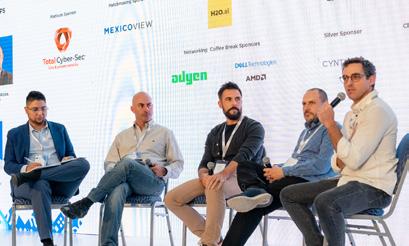
entities, substantial challenges persist.
“a s the value of SM e data increases, they become much more enticing for attackers. as they grow technologically, they inevitably have more external integrations in their daily operations, and their entire technology stack becomes much more fragmented,” says Paolo rizzi, Co- founder and director of technology, Minu.
SM e s in Mexico are vital economic engines as they generate about 75 percent of jobs and contribute more than 50% of the G d P. Hence, the urgency for a culture of cybersecurity, starting with owners and decision-makers, as well as each employee who uses a computer for any activity within the company, as previously reported by MBN.
Víctor Lima, C to , Un d ostres, says SM e s and startups often struggle to survive a cyberattack due to their size. SM e s have limited capital, so knowing how to focus it is crucial. He adds that SM e s and startups must ask how they can mitigate as much damage as possible with the least amount of spending.
o perating on tighter budgets, these SM e s often lack dedicated cybersecurity teams or adequate resources. this constraint has a cascading effect, hindering their ability to invest in training, procure comprehensive cybersecurity tools and solutions, and comply with regulatory requirements and industry standards such as the Personal
d ata Held by Private Parties (L f P d PPP). a s a result, these challenges significantly impede SM e s’ capacity to safeguard themselves in an ever-evolving threat landscape.
If left unaddressed, SM e s risk being marginalized or left behind, underscoring the urgent need for proactive measures to bolster their cybersecurity resilience. d espite their limited resources, however, o mar Herrera, CIS o , Stori, notes that SM e s and startups can leapfrog several generations in terms of infrastructure to tackle cyber threats if guided properly. “ o n the other hand, larger companies
may have more and thick cybersecurity layers that may not always be up to date. It is much more difficult to protect something that is not new,” adds a ndrew James devlyn, Co- founder and director of operations, fairplay.
experts emphasize the crucial role of proper training for SM e s’ workforce. enrique, Ceo, r ankmi, says that startups can even be more secure than larger companies initially. However, as they grow, this can change. In many cases, leaks are not due to the services used but to human errors. there is a much greater need for management, and technology already exists to address this.
Quantifying cyber risk is a critical process for companies of all sizes, enabling them to gain a deeper understanding and effectively manage exposure to potential adverse events impacting their operations, finances, and reputation. Methods like qualitative and quantitative analysis, the faIr (factor a nalysis of Information r isk) framework, and specialized tools have streamlined this process, ensuring operational integrity.
In an era of rapid digitization, companies confront escalating cyber threats that jeopardize critical assets, financial wellbeing, and customer trust. Without a clear
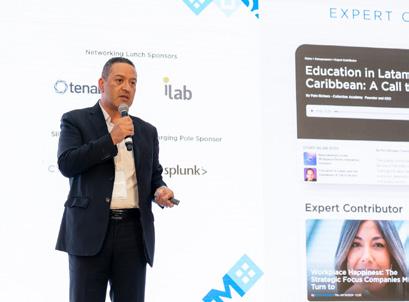
grasp and efficient management of these risks, organizations face substantial financial losses, reputational harm, and diminished competitive edge.
a ccording to a survey conducted by accenture, 68% of companies do not have a system in place to quantify cyber risks. In addition, a study by HISC oX revealed that 72% of cybersecurity decision-makers do not have a complete view of risk within their organizations. responding to this need, Netrum, in collaboration with CIS o s and CIos, proposes the implementation of SIta , a platform designed to revolutionize the understanding and management of cyber risk.
SI ta provides CIS o s with a powerful tool to determine appropriate security investments,” explains Juan Carlos Cortés, Senior Sales Consultant, Netrum. “this helps strike the optimal balance between risk objectives and budgetary needs.”
SI ta offers two primary approaches: Professional and e nterprise. t he former delivers insights and security operation reports, while the latter features a patented model based on best practices but simplified for organizational use.
“ t he initial approach focuses on asset identification, pinpointing inherent risk
points based on the asset, its vulnerabilities, internal or external threats, and the threat landscape,” elaborates Cortés.
Moreover, SI ta addresses risk beyond assets by managing risks associated with human errors and misuse within the organization. t he platform not only scrutinizes digital infrastructure but also considers the human element, a significant cybersecurity vulnerability. It assesses staff behavior and potential failures in internal processes.
“We can gauge user contribution to estimated asset risk levels through 40 to 45 questions.
t his allows us to reduce risk effectively,” notes Cortés.
additionally, the platform facilitates estimating the return on investment for each implemented control point, making it comprehensible for management and illustrating the benefits of cybersecurity investment.
While implementing SIta presents challenges like integration into existing enterprise systems and staff training, its adoption is anticipated to become standard practice for companies aiming to safeguard their assets in an increasingly complex and menacing digital landscape.
technology stacks, which combine various technology products and services, have become fundamental elements essential to running an efficient business for companies of all sizes in Mexico. However, amid the rapid pace of digitization, technology stacks have grown increasingly complex, bringing forth significant security risks.
t hese risks range from vulnerabilities stemming from outdated software to challenges in timely implementing security

updates, presenting ongoing challenges for companies striving to safeguard the integrity and confidentiality of their systems and data. “We tend to adopt new technologies, which can sometimes lead to a larger attack surface, especially when lacking a well-defined strategy,” said, rafael Verduzco Vázquez, Cofounder and Cto, Zenda.la.
t hese risks have spurred efforts within companies to simplify their technology stacks. yet, achieving this goal is not without its challenges. t he primary challenges of this endeavor include the integration of legacy systems, ensuring interoperability and compatibility, and overcoming internal resistance to change. “It is important to have good architecture. a structure that is too dispersed and not uniform does not allow for control. It is necessary to standardize all the technologies in use,” said federico Cedillo, CI o and C to, financiera Contigo.
to effectively mitigate associated security risks, enterprises can reduce complexity and standardize the platforms and tools they use. a dopting approaches such as containers, microservices, and Infrastructure-as-Code (IaC) presents an efficient strategy for simplifying technology stacks, offering flexibility, scalability, and notably, enhanced security. By prioritizing
a leaner, standardized technology stack, organizations can optimize their resources and diminish the attack surface for potential vulnerabilities.
It is imperative to engage all stakeholders from the outset and foster effective communication to proactively address these challenges. Moreover, companies must prioritize conducting comprehensive security audits and establishing clear processes to ensure business continuity throughout the transition.
In today’s ever-changing business environment, the ability to adapt and innovate is essential for achieving success. However, companies often encounter obstacles when trying to adopt new technologies and unconventional methods, such as limited resources, knowledge gaps, or resistance to change.

“It is no secret that artificial intelligence has been a hot topic for the past 18 months, and it shows no signs of slowing down”
Víctor Moctezuma CEO | iLab
to tackle these challenges head-on, iLab Solutions offers a holistic consulting approach that blends technological innovation with disruptive methods. “What we need are a series of hypotheses that allow us to establish a framework. t hings are a bit more complex because it is not just one competitor; it is a series of variables,” explains Víctor Moctezuma, C eo , iLab. t his strategic approach enables organizations to pinpoint areas for improvement and implement solutions that set them apart in the market and drive value creation.
Implementing these solutions comes with its own set of challenges. r esistance to
Santiago fuentes, Co-founder and Ceo, delta Protect, believes that companies’ evolution in their tech ecosystem and standardization should stem from internal initiative, rather than just for compliance, which is becoming increasingly relevant.
Greater collaboration is anticipated among service providers to offer integrated and simplified solutions that address the specific needs of the Mexican market, thus promoting a more secure and efficient technology ecosystem.
change, resource constraints, and the need for proper training may arise. Moctezuma acknowledges this, stating, “ o ur horizons are very short-term, and almost all decisions are made on an annual basis. Very few companies still have plans for the next three to five years, and practically none for ten years.” Nevertheless, iLab Solutions provides tailored training programs and ongoing support to help overcome these obstacles.
a daptability and innovation are pivotal for business success in a rapidly evolving landscape. “It is no secret that artificial intelligence has been a hot topic for the past 18 months, and it shows no signs of slowing down,” remarks Moctezuma. He emphasizes that companies must grasp emerging trends to strategically plan their futures and avoid being left behind.
Moreover, iLab Solutions underscores the importance of understanding market trends. “It is about navigating the conditions and analyzing what is necessary for growth,” points out Moctezuma. t he company not only delivers solutions but also aims to educate its clients on the tools and processes required for success.
“It is not about blindly copying what competitors are doing; it is about comprehending the tools, processes, business models, and environments in which they thrive,” added Moctezuma.
In today’s digital era, customers engage with brands across various physical and digital platforms, but expect consistent and streamlined experiences across all channels. to achieve this, retailers are implementing solutions that leverage customer and retail data to enhance conversion rates. armed with market insights and consumer behavior data, retailers can optimize pricing strategies, product assortment, and promotional activities.
t he integration of several platforms, known as an omnichannel strategy, has become vital in influencing purchasing choices, according to the Mexican o nline Sales a ssociation (a MVo). t his strategy benefits from advanced data analysis, which enables retailers to better understand consumer behavior, optimize inventory, and improve operational efficiency. t his not only translates into greater profitability but also fosters a more satisfying shopping experience for customers.
But before discussing omnichannel, it is crucial to fully understand the potential customer, says edgar embriz, Ceo, Swatch. “ the challenge lies in understanding each customer, because omnichannel works only when the customer is understood. technology is a means to an end, and it should adapt to the customer’s needs at each touchpoint with different brands,” says embriz.
technology allows retailers to analyze consumer behavior data to optimize pricing strategies, product assortment, conversion rates, and promotional activities. additionally, precise demand prediction, using both past and present data, facilitates effective inventory control, minimizing both excess inventory and stockouts, according to turing.
a nother challenge lies in a consumer that is becoming increasingly demanding, says fabricio Moreno, Country Manager, adyen.
t hese customers not only demand more features but also a simple, streamlined experience across all of them, which can pose problems to companies of all sizes. “o ur survey showed that 56% of customers claim to be more loyal to a brand that allows online purchases with easy returns. However, despite seeming easy, integrating back-office systems with separate systems and different stocks poses a significant challenge for the industry. It is essential to check if systems are connected, if suppliers are the same, and if there is the same stock to reduce friction and enhance the experience,” says Moreno.
technology can be a solution for these problems. a Microsoft and I d C report found that in late 2023, over 70% of US businesses leveraged a I, with 92% of a I implementations completed in less than a year. Companies witnessed returns on their aI investments within 14 months, found the study. on average, for every US$1 invested in aI, businesses are experiencing a return of US$3.5.
e nsuring that customer and business information is protected at all times is another challenge, especially as the use of technology becomes prevalent. “ t he challenge across industries is consolidating information, data, and platforms into one place to integrate digital and physical channels end-to-end for complete visibility. However, in terms of technology, cybersecurity, including biometrics, poses another significant challenge as integration is necessary to enhance security and the user experience,” says o mar Pérez, regional Sales d irector Mexico and North Latam, Splunk.
Biometric data, as a means to verify customer identity, is gaining traction in the retail industry, promising to streamline transactions, bolster resilience, and mitigate fraud. this technology also has the potential to differentiate stores and enhance revenue,
as customers are drawn to novel shopping experiences.
“Improving technology experience relies on understanding the customer. Incorporating biometrics is applicable as customers seek speed and security. Customer trust in the brand depends on their needs. t he tool implemented depends on the customer type. from the company’s perspective, fraud prevention and data management are vital and relevant to technology departments,” says embriz.

“The challenge lies in understanding each customer, because omnichannel works only when the customer is understood. Technology is a means to an end, and it should adapt to the customer’s needs at each touchpoint with different brands ”
Edgar Embriz CEO, Swatch Group Mexicoexperiences and generate campaigns for both physical and digital channels,” says López.
d espite the increasing volumes of data collected by retailers, including workforce metrics and customer and sales analytics, only 36% of companies feel confident in their capacity to safeguard customer information from cyberattacks, according to own data. this discrepancy persists even as the number of companies implementing data strategies grows exponentially.
“Changes in payment methods have completely transformed experiences, making payment processes transparent and frictionless. However, reducing information and clicks for smoother processes compromises anti-fraud measures due to less customer data. there must be a balance, and biometrics play a role. In Mexico, where 55% of people have experienced fraud, preventing it is crucial to ensuring a good experience and reducing fraud for both companies and users,” says Moreno.
In June 2023, fraud pressure and attempts against merchants surged by 68% compared to a pril of the same year, making a 106% increase compared to May 2022, reports the Mexican online Sales a ssociation (aMVo).
d igital fraud prevention engines play a crucial role. Without a physical card present, identifying the buyer becomes challenging, contributing to Mexico’s high fraud rates. tools like fraud prevention engines, powered by a I, validate transactions and determine whether to proceed, explains rolando López, director e-commerce and o mnichannel, Grupo o primax (o ffice Max & Par ty City).
“Platforms using aI offer a better shopping experience in digital channels. In physical security, biometrics and blacklists are essential. even with prevention systems, there is always a risk of theft. However, with fraud prevention systems and biometrics, stores can deter it. Video analytics and biometrics, with the agreement of customers, can be used to improve shopping
a nother challenge is dismantling data silos and integrating processes within the business. “a unified data platform is the key to unlocking deeper insights, as it gives retailers the ability to drive more meaningful experiences for customers. r etailers can open the door to next-generation retail data solutions and more actionable insights with a unified data estate,” according to Microsoft.
one of the biggest challenges is seamlessly integrating physical and digital commerce to ensure seamless integration across all systems, all while ensuring that the data is safe at all times, says López. “ t he key to omnichannel is building trust that data is appropriately used and safeguarded,” says López.
López highlights another challenge within data lies in analyzing the vast amount of information to understand customer history accurately for precise personalization. Customers seek exclusivity and demand
a personalized shopping experience, achievable only through technological tools and data scientists correlating information for marketing or commercial purposes.
“Understanding the user is key,” says e mbriz. With data from various sources,
it is possible to identify customer profiles, crucial for maintaining loyalty and understanding the customer better over time. Based on this data, creating ad hoc profiles to make digital campaigns, offer benefits, and enhance experiences becomes possible.
a s e-commerce continues to escalate, integrating sustainability into every aspect of the supply chain will be crucial for building a more resilient and environmentally conscious future for the sector. By embracing reverse logistics, e-commerce companies can not only minimize their environmental impact but also enhance customer satisfaction and drive long-term business growth.
Javier dolcet, Ceo and Co- founder, dawa, shares his insights on the pivotal role of reverse logistics in fostering sustainable growth within the e-commerce sector. With over eight years of experience in the Mexican e-commerce landscape, including roles at Privalia and Mercadolibre, dolcet provides valuable perspectives on the challenges and opportunities facing the industry.
d olcet highlights the exponential growth of the e-commerce industry globally, which now represents a market of over US$6 trillion. In Mexico alone, e-commerce sales are projected to reach US$38 billion this year, with a penetration rate of around 10 to 12%. However, this growth has brought about significant challenges, particularly in managing produc t returns.

r eturns have become a major challenge for e-commerce companies, with rates averaging around 15% globally. In industries such as fashion and jewelry, return rates can soar to as high as 35%. t hese not only impact sales revenue but also pose environmental concerns, as a substantial amount of returned products end up as waste. Moreover, out of the visitors an e-commerce site gets, 45% of consumers opt out of purchases due to poor return policies. “Implementing a good return policy alongside efficient automated reverse logistics significantly impacts several business KPIs,” emphasizes dolcet.
to address these challenges, d olcet emphasizes the importance of optimizing reverse logistics processes for sustainability. By implementing advanced technology solutions, e-commerce companies can streamline the handling of returns, reduce waste, and improve efficiency.
dolcet highlighted several key strategies for optimizing reverse logistics:
• advanced analytics. Leveraging data analytics and machine learning algorithms to predict return rates and identify patterns in consumer behavior.
• Product resale and refurbishment. refurbishing and reselling returned items through secondary markets or donation programs to extend the product lifecycle and reduce waste.
• Collaborative Partnerships. Partnering with third-party logistics providers, recycling facilities, and nonprofit organizations to streamline reverse logistics processes and facilitate responsible disposal of returned goods.
• Customer education. educating consumers about the environmental impact of product returns and promoting responsible purchasing behavior to reduce return rates.
d olcet explains there is an immense opportunity for e-commerce companies to leverage reverse logistics for sustainable
growth. Integrating sustainability into reverse logistics processes is not only a moral imperative but also a strategic business decision. “By embracing sustainable practices, e-commerce companies can build a more resilient and environmentally conscious future for the industry, while driving growth and profitability.”
t he retail sector has undergone rapid transformation spurred by the surge in online shopping and the adoption of new technologies like a I and data analytics. While traffic in fashion malls and physical stores has improved in the last couple of years, companies are encountering fewer instore transactions and increased customer demand for streamlined experiences. However, brick-and-mortar stores can still thrive, especially when integrated with new technologies.
“This

allows us to personalize marketing strategies, avoid customer saturation, and generate engagement and loyalty. The integration of AI technology helps us understand customer purchasing habits and further personalize their experience”
Laura Torres del CuetoManaging Director
Mexico & LATAM | Hugo Boss
a ccording to the Mexican o nline Sales a ssociation ( a MV o), 75% of shoppers prefer a combination of online and physical stores. “ t he integration of functionalities between both channels, such as locating physical stores from the website, being able to click and collect, making returns in physical stores, or being able to make online purchases either through kiosks or through a salesperson are important values in the consumer’s omnichannel experience,” says aMVo
While customers want to visit both physical and online stores, their preference for one
over the other varies widely depending on the sector. High-end, for example, remains largely traditional in certain aspects, says Marco di Santo, Managing director Mexico, Bvlgari. In this segment, online commerce represents a small portion due to customer distrust and their preference for physical experiences.
“ t here is a customer journey, a transition between physical and digital that is considered outdated. People search online and then go to the physical store to analyze the product. Particularly with jewelry, an immediate purchase is not common; there is a deeper emotional connection that customers consider. from physical, it returns to virtual, where the seller sends options and photos, and the customer makes the virtual purchase then,” says d i Santo.
Companies are implementing digital solutions within physical stores, like augmented reality and virtual showrooms, to entice consumers to enter and buy instore. this not only decreases the probability of product returns but also enriches the overall online shopping journey, closing the divide between the digital and physical retail realms. Companies like Caper Carts are implementing a I and retail media on shopping carts to automatically identify items placed in the basket, enabling customers to bag items while shopping and conveniently check out directly.
technology support is essential and augmented reality plays a key role in helping to enhance the customer experience, says
Cristian Campos, e -Commerce Manager, Samsonite, adding that companies must make the most of available data.
o mnichannel has become crucial to the modern shopping experience, but it is also necessary to ensure that any point of contact provides the same pleasant experience, explains Laura torres d el Cueto, Managing director Mexico & Lat am, Hugo Boss. “We are integrating technology into our strategies. for example, in fashion shows, customers can click and buy the garment. We have also implemented an internal chat for the company and introduced the “Boss House Valley” virtual experience with augmented reality to offer different friendly experiences beyond the purchase,” says torres.
a nother modality that has become popular is the virtual try-on, which also increases online engagement, says d i Santo . “at the same time, in the physical realm, we have invested in technology like o culus to offer three-dimensional experiences to customers. e vents have also been impactful; we have taken them to immersive environments to create memorable memories. t he pandemic has driven us to create memorable experiences that foster customer loyalty,” says di Santo.
to stay ahead, companies need to stay in constant communication with clients, explains e miliano Segura, Co- f ounder, clic o H. d ata collection can be essential in enhancing communication, says torres. “ t his allows us to personalize marketing strategies, avoid customer saturation, and generate engagement and loyalty. t he integration of a I technology helps us understand customer purchasing habits and further personalize their experience,” she adds.
a robust Cr M is also fundamental. “[Cr M] helps us understand our customers and predict their purchasing needs. We are developing a customer acquisition module to further improve our communications and offer unique experiences that strengthen the brand relationship”, says di Santo.
the number of online marketplaces keeps growing in Mexico, which experienced a 78% increase in sellers in 2023, according to a study by retail Compass. the Mexico retail market size was MX$7.78 billion in 2022 and is expected to grow at a Compound a nnual Growth r ate (C aG r ) of over 6% during 2022-2027, according to Global data. the growth is attributed to the integration of omnichannel solutions and other technologies to meet customer demands.
Given the interconnectedness and interdependency of Mexico’s financial system, the potential systemic implications of a cybersecurity shock on the financial system could be severe and far-reaching. Industry experts delineate some of the potential risks and avenues for safeguarding Mexico’s financial ecosystem, crucial to the stability of the national economy.
“detecting is a hope, preventing is desirable. We know that these attacks are going to come, so we have to be prepared to face them,” says Santiago Gutierrez, Lead Partner Cyber risk Services & Commercial d irector e nterprise r isk Services ( er S),
deloitte Mexico. Gutierrez further highlights. “ the financial sector continues to be one of the most attacked sectors.”
Mexico’s financial system is characterized by a complex network of financial institutions, markets, and participants, which play a pivotal role in facilitating the flow of capital, trade, and investment channels. t he interconnected nature of these networks not only amplifies the efficiency and liquidity of the system but also promotes risk diversification and resilience to economic shocks. However, while this interconnectedness has historically spurred economic growth, it is increasingly viewed
as a potential source of concern due to the risk of widespread disruption or complete collapse of the financial system, rather than isolated impacts on individual institutions or markets.

“a cybersecurity shock represents a formidable threat to the stability of our financial system. o ur paramount strategy lies in fortification. t he undeniable interdependence among financial networks underscores a sobering reality—one that has historically exerted profound repercussions on our economic landscape,” says francisco Garcia, Global Security o fficer at BN P Paribas.
t he interconnectedness and interdependence among financial institutions and markets magnify the repercussions of any cybersecurity event, potentially triggering a domino effect that could jeopardize the economic stability of countries. f actors such as interconnectedness, contagion, complexity, and regulatory challenges are pivotal in heightening the vulnerability of the Mexican financial system to systemic risks. However, the implementation of solutions to mitigate these risks encounters substantia l hurdles.
eduardo amaya, director of Cybersecurity a udit and Consulting at Cynthus Group, underscores the formidable challenge of
mitigating the intertwined financial risks and reputational repercussions. o ver the long term, these consequences possess the capacity not only to dismantle institutions but also to erode investor confidence, thereby impeding the macroeconomic advancement of economies. “ t he recent surge in financial attacks underscores their transformative nature from mere operational risks to systemic threats,” he contends.
resistance to change among certain financial institutions, inadequate resources, and investments for conducting comprehensive stress tests, along with the imperative for skilled international coordination, are among the challenges that must be surmounted. a dditionally, there is a pressing need to adapt regulatory frameworks to effectively address the evolving landscape of financial and technological risks. to tackle these challenges, it is paramount to conduct a holistic assessment of the vulnerabilities inherent in a growing and increasingly digital financial system.
this entails identifying weaknesses within the financial system, conducting stress tests to assess its resilience, monitoring macroprudential indicators, and reanalyzing the causes of past financial crises. Lessons from past financial crises, such as the 2008 global financial crisis, underscore the importance of proactive measures to identify vulnerabilities and enhance resilience.
“ t he dynamic evolution of financial markets, propelled by rapid technological advancements and the forces of globalization, underscores the imperative for constant adaptation of regulatory frameworks. t his perpetual adaptation is essential for effectively addressing the ever-emerging risks that accompany such transformative shifts,” says r oman Baudrit, a ssociate VP of Sales - L ata M, thales Group.
a s technological advancements continue, systemic risk in the Mexican financial system is anticipated to remain a significant
concern. However, the establishment of more resilient financial systems is achievable through the implementation of robust regulatory frameworks, adept risk management practices, transparency,
and enhanced international cooperation, according to industry expert insights. these measures are indispensable for mitigating risks and nurturing a stable economy over the long term.
Businesses are entering a new era of artificial intelligence (aI) applications, but according to Pablo Corona, President, Mexican Internet a ssociation, current technologies are not yet accurate enough to fully replace humans. t his sentiment was expressed during the Mexico Business forum 2024.
a I has become an essential tool for businesses across all industries, with machine learning emerging as a fundamental technology. Corona highlighted this trend during the Mexico Business forum 2024, stating that we are entering a new era of aI applications. However, he acknowledged that machine learning models often lack transparency and are challenging for people to comprehend.
In the ongoing digital transformation, aI has ushered in the fourth Industrial revolution, characterized by interoperability, customercentricity, innovation, automation, decentralization, and interconnectivity. according to darPa , the development and integration of aI in business activities have progressed through three waves: e xpert knowledge, Statistical learning (the Big data e ra), and Contextual adaptation, which is the current phase.

“although aI has the potential to significantly contribute to digital transformation, current technologies are unlikely to achieve selfawareness, attempt to escape or hide within programs or systems, self-replicate without instruction, or apply learning to other domains independently,” Corona explained.
However, Corona warned of various risks associated with a I implementation, such as mass data collection, undersampling, data security, bias, lack of transparency and accountability, secondary data use, anonymization, profiling, manipulation, and regulatory compliance. He emphasized that the complexity of the human brain makes it challenging to replicate accurately in a I systems, leading to errors and misconceptions.
furthermore, attackers exploit a I through algorithm attacks, data poisoning, social engineering, privacy breaches, malware proliferation, zero-day attacks, and hacking. Corona suggested leveraging Gen a I to address vulnerability issues and optimize a I defenses, but stressed the importance of human validation for a Igenerated data.
to address these challenges, Corona proposed several actions, including ethical a I development, user-centric approaches, adherence to regulations, verification and validation processes, and informed decision-making. He emphasized the need for interdisciplinary collaboration, involving experts from humanities to train aI systems with historical, sociological, ethical, and philosophical perspectives.
t he IS o /I e C 42001 standard for a I management systems aims to provide a certifiable framework for developing a I
products responsibly within an ecosystem. Corona stated that the standard aims to enhance the quality, safety, traceability, transparency, and reliability of a I
applications while reducing development costs, maintaining regulatory compliance, meeting stakeholder expectations, and improving efficiency and risk management.

In the Mexican financial sector, the growing threat of cyberattacks and the need to protect critical financial system services have led to an increased focus on security incident response strategies. a lthough modern security tools have improved the ability to defend networks and endpoints against cybercriminals, they still occasionally manage to infiltrate. to intercept these threats and restore normal operations as quickly as possible, industry experts emphasize the need for a wellprepared and knowledgeable workforce.
“It is not enough to know how to implement technology, we have to make sure our talent is well prepared to use and understand it,” Claudio Querol, Cybersecurity a ssociate Partner Specialist L ata M at McKinsey & Company.
a ccording to Kaspersky’s analysis, the digital transformation of the financial sector has increased exposure to cyber risks, as evidenced by the rising incidence of social engineering attacks and deliberate hacks.
“Before the pandemic, people went to the bank in the conventional way, but now, both young and old people have
adapted to the digitization of these processes,” a rturo r ivera f ermoso, CI o of Mifel. “ d igitalization has influenced all the parameters of our lives. t here is an obligation to protect investors, employees and partners”.
t his underscores the responsibility of financial institutions to safeguard the integrity of the entire ecosystem, which includes understanding their own value and critical services as well as the organization’s risk appetite.
However, several obstacles hinder the effective implementation of such response plans. these include the need for ongoing education, adaptive and scalable solutions, and a culture of security as the last line of defense against cyber threats.
“ e nterprises must have a layered, component-based approach to address the diverse cyber threat landscape that exists,” r afael Chávez, Country Manager Mexico at f5. “Moreover, the adaptability and scalability of solutions emerge as crucial factors for success, particularly in an environment where infrastructure costs loom large.
to address these challenges, it is critical to implement effective incident response strategies. t his involves adequate preparedness, ongoing staff education, and a rapid, coordinated response to threats. Integral to this response are endpoint detection and response ( edr ) tools and extended detection and response (X dr ) solutions, which play a crucial role in identifying and containing security incidents. In addition, the utilization of a security information and event management (SI e M) platform, coupled with robust data backup and recovery systems, is indispensable for ensuring a resilient and effective response to cybe r threats.
“We must see cybersecurity not as a cost, but as an investment, a competitive advantage,” Claudio Querol. this further reinforces the importance of viewing cybersecurity from a strategic perspective, aligning with the need for strong incident response capabilities as a competitive advantage that attracts customers to organizations with strong cybersecurity postures.
However, it is essential to recognize that while these measures are crucial, they do not offer a one-size-fits-all solution. Given the evolving nature of cyber-attacks and digital infrastructures, continual adaptation and enhancement of incident response strategies are imperative.
rising Latin american companies like Konfio, r appi, and Clip have leveraged emerging technologies like a I and cloud computing to disrupt their business verticals and economies to benefit their local consumers. However, to effectively compete in a global economy, entrepreneurs must comprehend the markets they serve and the niche problems they solve.

“Mexico has the talent to create robust AI models. However, it is somewhat limited. Companies technically compete for the few engineers and data analysts in the market. As companies like us expand their footprint, these careers will see increased demand”
us, aI streamlines user authentication and document verification, making processes more efficient. It can also improve user conversion by engaging in conversations to explain product benefits,” says Maite Muniz, Co- founder, truora.
Javier Mata Founder and CEO| Yalo
While implementing emerging technologies offers significant opportunities for growth and innovation, they also present challenges, such as data privacy concerns, cybersecurity risks, and talent shortages. a ddressing these challenges requires strategic planning, investment in infrastructure, and talent development. “Mexico has the talent to create robust a I models. However, it is somewhat limited. Companies technically compete for the few engineers and data analysts in the market. a s companies like us expand their footprint, these careers will see increased demand,” says Javier Mata, founder and Ceo, yalo.
the success of these startups underscores the transformative potential of aI and cloud computing in driving innovation and creating value in Latin a merica. By harnessing these technologies, entrepreneurs could overcome traditional barriers to entry, such as limited access to capital and resources, and establish themselves as key players in their respective markets. “ f or
Scaling a business to compete in the global economy presents various challenges, many of which can be effectively addressed with the help of a I and cloud computing. o ne of the primary challenges is ensuring that the infrastructure can handle increased demand and growth. Cloud computing provides scalable infrastructure resources
on demand, allowing businesses to easily expand their operations without the need for significant upfront investment in physical infrastructure. However, for Luis Barrios, C eo and f ounder, a rkangeles, the main challenge is not exclusive to Latin a merica.

Globally, regulation will play a crucial role, and issues like ethics in aI implementation must be addressed. Barrios advocates for entrepreneurs using a I to always seek ways to improve users’ lives, as creating a startup is usually about solving a problem in society.
a s businesses expand globally, they generate vast amounts of data from various sources, including customer interactions, sales transactions, and market trends. aIpowered analytics can help businesses manage and analyze this data more effectively, extracting valuable insights to inform strategic decision-making.
to succeed in global markets, businesses need to tailor their products and services to meet the unique needs and preferences of diverse customer segments, as well. a I algorithms can analyze customer data to identify patterns and trends, enabling businesses to personalize their offerings and marketing strategies for different regions and cultures.
d espite the challenges, the future of the domestic and Latin a merican market for a I and Cloud is promising. t he adoption of emerging technologies is expected to continue to grow, driven by the recognition of the benefits they offer in terms of efficiency, productivity, and business competitiveness. t hese technologies will not only improve the operational efficiency of Mexican companies but also open new opportunities for innovation and growth in various sectors of the economy.
Christine Kenna, Partner, IGNI a Partners, believes that companies implementing a I are poised for exponential growth, with investors showing keen interest in allocating capital to them. t his trend is particularly notable in Latin america, where experts see abundant opportunities for aI implementation. “ the easiest round is the first one, you realize this when you move on to the next ones. every business has flaws that investors will focus on and question. Companies must be prepared to answer,” added Courtney McColgan, f ounder and Ceo, runa H r
addressing gender disparity is crucial for technology companies, especially those involved in artificial intelligence projects. a ccording to UN e SC o figures, only 22% of professionals in the field are women.
“If we do not take action to integrate women into technology and a I development, everything will end up being developed by a non-representative population group,” says a naid Sustatia, Google Cloud Lead and member of Wome n in tech.
a ccording to the o rganisation for economic Co-operation and d evelopment ( oe C d ), only 11% of all research and development publications on artificial intelligence were exclusively authored by women. f urthermore, only 45% of all publications have at least one fema le author.
t he fact that the majority of specialists involved in the development and training of artificial intelligence systems are men
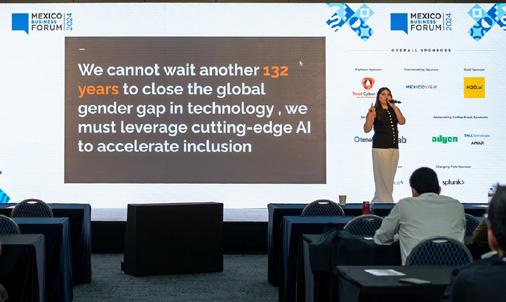
leads to perpetuating social biases within the digital environment, according to the s pecialist.
“It is important for policymakers, companies, and academia to develop programs that promote women’s inclusion in the industry, allowing them to contribute to the execution of these projects”, says Sustatia.
Google develops projects in this technology based on what they call the principles of aI. “ the first is to ensure that they benefit the entire community, seeking not to reinforce societal biases. It must be developed in a safe environment, feedbacked, and controlled by humans, taking care of people’s data. It must be developed with scientific excellence and all aligned with Google’s values,” says a specialist.
In order to promote women’s inclusion in aI development, Google has implemented a series of initiatives focused on addressing this issue. Women Growth is one of them, teaching women all the basics in a I technology, Cloud, and complemented with mentorship for the development of soft skills to enable them to achieve greater success in their careers.
a similar case is the Women Will program, which focuses on S te M students and technology careers, so they can implement a I and cloud to allow them to access
better positioning in the job market upon graduation.
“It is important to have policies from the beginning to the execution of aI development projects so that they can incorporate their input. there are mentoring projects so that young women have the opportunity to have a career in aI development; several of the participants have launched their own startups,” says Sustatia.
d ue to this, non-profit organizations develop programs to help reduce the gender gap. a n example of this is the future Leaders association, of which anaid Sustatia is a part and which is divided into two aspects.
“o ne for women with eight to ten years in technology industries looking to advance their careers, accompanied by 30 women leaders in the industry. the other program is allied with women in and the University of Puebla to give students negotiation mentors so they can enter technology and help improve gender parity from this moment,” she stated.
according to UN e SCo, at the current rate, it would take another 132 years for men and women to close the gender gap in technology. therefore, initiatives like those of Google and Women in tech should be replicated and promoted.
Startups leveraging artificial intelligence ( a I) are rapidly innovating, scaling, and disrupting their industries, capturing the interest of venture capital firms eager to invest in this high-growth market. a s demonstrated by substantial investments in aI startups such as openaI, Hugging face, and H2 o.ai, the a I sector is seen as a key driver of future success. to secure funding in this competitive landscape, startups are advised to not lean solely on technology itself, but on the problems it solves and the efficiencies it creates.

“AI is just a tool, not a product to sell. Back to basics, if you have an innovative solution and business model, it means you have competitive advantages on the talent side”
Rafael de Haro Co-Founder and Managing Partner | Cometa VC
newer technologies. “a s VCs considering entering a new company, we should ask how they are implementing these technologies to save time and create more value. We need to go a step further and demonstrate that the company teaches employees how to use the available tools to become more efficient,” she adds.
the adoption of aI in Mexico is on the rise, as the country ranks fifth in Latin america for enterprise aI implementation according to recent studies by dell and other technology firms. aI is being integrated across various sectors, including government, enterprise, education, and startups. María f ernanda González, Principal, Hi Ventures, says that one of the main questions that might arise among entrepreneurs is how this technology affects the way a company is evaluated, potentially requiring the application of a new investment thesis.
a I offers startups powerful real-time analysis capabilities, enabling them to swiftly identify and respond to emerging market needs. this agility allows companies to adapt their offerings and strategies on the fly, giving them a competitive edge in rapidly changing industries. Venture capital (VC) investors are drawn to this potential, recognizing the opportunity to back the next market winners poised for rapid growth and disruptive innovation. By investing in aIdriven startups, investors hope to capitalize on these businesses’ ability to harness data and technology to stay ahead of market trends and consumer demands.
a ntonia rojas, Co- founder and Managing Partner, a ttom Capital, considers 2021 a glorious year for the tech world and at the same time catastrophic, as companies boasted about how many people worked for them. Now, the paradigm has shifted to how they can improve those efficiencies with technology. She associated some of the tech layoffs with the implementation of
While this technology offers several opportunities, experts suggest that companies seeking capital cannot base their pitches on a I, suggesting that the investment thesis might have not changed significantly. rafa de Haro, Co- founder and Managing Partner, Cometa, stresses that the correct strategy for raising capital has not changed. according to him, companies need to avoid falling for all the hype around aI, instead focusing on understanding their business model well. “aI is just a tool, not a product to sell. Back to basics, if you have an innovative solution and business model, it means you have competitive advantages on the talent side,” he added.
data management and preparation, model training, and personalization are the main challenges a I faces for its effective implementation within the Mexican business landscape. Likewise, the efficient management of large volumes of data and adequate training of personnel are crucial for the success of aI in Mexican companies. Juan franck, Managing Partner, SoftBank,
highlights that the effectiveness of a I hinges on the quality of the information it receives. He notes that information is readily available and transparent in developed markets, offering equal access to all platforms. t his accessibility not only creates investment opportunities but also underscores the importance of talent and its contextual unde rstanding.
“Information in L ata M is harder to come by, so platforms that can consolidate this information and provide
contextual insights will offer interesting opportunities,” he says.
alejandro diez Barroso, Managing Partner, dIL a Capital, says that artificial intelligence can also benefit VCs in streamlining processes. He mentioned that they follow a traditional approach, providing a detailed investment memorandum for each company they are interested in. “on average, analysts took 24 hours to draft these documents. However, with aI, they now complete the same task in just 30 minutes,” he exemplified.
r apid technological evolution, changing consumer preferences and increasing competition are just some of the forces contributing to market disruption. today, companies are challenged to make informed decisions in an increasingly volatile and complex business environment; conventional forecasting methods frequently prove inadequate in anticipating swift and profound shifts in the market. Consequently, there has been a burgeoning interest in deploying predictive analytics. Nevertheless, industry experts assert that while this modeling technique holds significant promise, its current state remains nascent and necessitates human guidance.
“ the data generated primarily reflects past occurrences, inherently constraining the efficacy of predictive analytics. our present challenge lies in discerning the requisite
additional variables—both internal and external—that must complement existing datasets to accurately forecast market trends,” explains Gabriel fernandez, director of Innovation and Iot at at&t Mexico. a s a result, he emphasizes, “[t]he human element remains indispensable as a critical validator within this analytical framework.
Given the nascent stage of predictive analytics, its effective integration within the Mexican business landscape encounters several challenges. a study conducted by It consulting firm Ultree has identified current hurdles facing this analytical approach, notably the requirement for expertise in statistical modeling and programming. this expertise gap poses limitations, particularly for teams lacking specialized knowledge. diego Sánchez, Global e-business director at Mabe, concurs, highlighting the prevalent culture within companies that heavily relies

on retrospective reports and performance analysis. transitioning away from this entrenched practice presents a significant cultural challenge for organizations. Sánchez suggests initiating this transition through small-scale projects with clearly defined objectives, gradually expanding their scope over time.
a n additional significant challenge lies in the ‘black box’ nature of predictive models, which can obscure transparency and hinder interpretation, thereby impeding effective decision-making. to address this issue, d ario García, Chief technology o fficer Latam at ManpowerGroup L ata M, underscores the necessity of establishing clear governance rules, defining variables, and outlining parameters for projects. this step is paramount for monitoring and evaluating the efficacy of predictive models, particularly during the experimental phase of predictive analytics. furthermore, given the involvement of multiple stakeholders, such documentation becomes indispensable. this
trend reflects a broader shift towards greater transparency and ethical considerations in data-driven decision-making processes, driven by concerns around bias, fairness, and accountability.
d espite encountering several challenges, the significance of predictive analytics in addressing diverse market issues remains indisputable amidst the backdrop of escalating business competition and the continual adoption of novel technologies, affirms Jorge Mandujano, C eo of Beyond technology. Nevertheless, fully capitalizing on predictive models within the Mexican market necessitates a commitment to utilizing high-quality, validated data, fostering cultural transformation within companies, and ensuring transparency in predictive analytics projects. a s predictive analytics evolves, leveraging advanced artificial intelligence and machine learning techniques becomes imperative for more accurately anticipating market dynamics and emerging trends.
a rtificial intelligence ( a I) is rapidly transforming industries worldwide, with new product and service development, marketing, and sales being the areas witnessing the greatest implementation. In this context, companies and people must be aware of the level of adoption of such technologies, to better understand where its implementation is going, suggests f rancisco a guirre, L ata M a rtificial Intelligence Senior Principal, d ell tech nologies.

“Constant
training
is essential to have a
solid model. It is necessary to keep feeding algorithms to verify the accuracy of certain data. Furthermore, organizations need to consider where the model will be implemented”
Francisco AguirreLATAMArtificial Intelligence Senior Principal | Dell Technologies
a guirre noted that a I is highly present in daily activities and that recreational uses are among the main a I applications. However, he noted that a I adoption is gaining steam among Mexico and L ataM’s companies, similar to the global average. “If one wonders if we are falling behind in a I in Latin a merica, we are not. Globally, companies are just starting to integrate aI,” aguirre says, adding that aI is not new, as this technology has been developing for decades. “It is here to stay,” he says.
Studies have shown that a I can lead to price reductions of over 20%, particularly in product and service development, marketing, sales, and corporate strategy and finance, where significant savings have been identified.
In the financial sector, some banks leverage aI applications to connect their services with digital assistants, streamlining transactions and providing real-time balance alerts
to protect customers’ finances. t hese applications can also schedule payments automatically, enhancing convenience and security. a dditionally, a I is increasingly being used for decision-making, providing real-time, accurate information and analysis that empower business leaders to make informed decisions.
t hese applications are possible due to a I’s ability to examine vast amounts of data to identify patterns and trends that may be challenging for humans to detect. this capability is driving advancements in data analytics and automation, enabling companies to automate manual and repetitive tasks, saving time and reducing errors. aguirre emphasizes that the growing importance of a I is due to the fact that businesses today operate with a larger amount of data compared to previous decades. “ today, we are doing more with data than would have been impossible without the algorithms,” he added.
Looking ahead, the adoption of a I is expected to continue to grow. a survey found that 45% of executives plan to increase their company’s investment in aI, with 75% of large companies aiming to use a I to increase efficiency and improve product quality. furthermore, by 2026, the design and development of applications and websites are projected to be closely associated with Generative aI.
In Mexico, aI adoption is on the rise, making it the fifth Latin a merican country with
the highest a I adoption rate. to meet the growing demand for a I technology, there is an estimated 65% increase in demand for programmers in Mexico over the next 20 years. However, with only 2% of economically active individuals currently dedicated to IC t, there is a pressing need to cultivate a skilled workforce to support Mexico’s aI-driven future.
I t leaders are particularly aware of a I’s potential, with 86% expecting Generative a I to play a prominent role in their organizations. Given a I’s ability to write code, troubleshoot complex technical issues, and transform data management, continuous learning and adaptability are crucial for It workers to stay ahead in this rapidly evolving landscape.
aguirre stresses that aI, different to other technologies, is not a passenger trend, but a technology that came to stay, as it has been implemented for decades. In this sense, he notes that for a I to work properly and meet any organization’s goals, it is important to pay attention to the quality of data input, as well as constant training. “Constant training is essential to have a solid model. It is necessary to keep feeding algorithms to verify the accuracy of certain data. furthermore, organizations need to consider where the model will be implemented,” he adds.
regarding the future of a I, aguirre states that d ell’s focus is on the a I f actory platform. t he company aims not only to

utilize use cases but also to leverage the cloud, edge, and data center to provide comprehensive end-to-end solutions. aguirre notes that d ell is closely working with leaders in the aI market.
dell has shifted its focus from being solely a platform provider to becoming an endto-end solutions provider. aguirre notes that the company has established use
cases in the region for its solutions. d ell’s approach encompasses various aspects, including platform and data management, as well as server management. aguirre says this highlights the importance of having a strategic ally in processing, where I t company a M d plays a crucial role. a M d ’s contribution is essential for these processes, not only at the processor level but also at the GPU level, he concluded.
o rganizations are contending with a burgeoning influx of data, characterized by its exponential growth in both volume and variety, thereby widening avenues for monetization. a dvancements in technology have facilitated more efficient data management, empowering companies to optimize the utilization of their data assets. Nevertheless, findings from a study conducted by the consulting firm McKinsey reveal that merely 41% of surveyed companies have initiated deeper exploration into this domain within the market.
“developing an impactful data monetization strategy requires a keen focus on addressing specific customer needs or use cases,” emphasizes d enis Genova, C eo and founder, Xaldigital. “It entails a deliberate exploration of the value that data brings and how it can directly benefit our operations, rather than mere accumulation for its own sake. Precision and accuracy are paramount considerations in this endeavor.”

“it
is imperative not only to analyze internal data but also to consider the entire ecosystem, including suppliers, customers, intermediaries, and other relevant entities”
Ignacio Madrid Head ofData Management | Citibanamex
Crafting a robust data monetization strategy necessitates a comprehensive analysis not only of the quality of data within the organization but also across the entire ecosystem, encompassing suppliers, customers, intermediaries, and other stakeholders. this holistic approach enables the transformation of raw data into actionable insights that drive corporate performance and strategic decision-making. By scrutinizing the quality and relevance of data sources, organizations can ensure the usability and value of their data assets.
t he sluggish advancement in data monetization strategies is evident, with only 17% of companies having initiated such endeavors. according to a study by tableau, approximately 12% of companies are in the process of developing prototypes, while 10% are still at the conceptualization stage. the slow pace of progress can potentially be attributed to the formidable challenges surrounding data acquisition, secure information management, and solution scalability. t hese hurdles persistently impede the efficient implementation of data monetization strategies across enterprises.
according to Ignacio Madrid, Head of data Management, Citibanamex, “it is imperative not only to analyze internal data but also to consider the entire ecosystem, including suppliers, customers, intermediaries, and other relevant entities.” Madrid emphasizes that drawing insights from successful cases can continuously showcase the competitive advantages offered by data monetization. Juan Jose denis, Mexico Country Manager at BMC Software, underscores the critical nature of leveraging data assets to gain a competitive edge, highlighting that “whether the data originates internally or externally,
its primary focus should be on enhancing market understanding and organizational efficiency.” He substantiates this by citing that 80% of the company’s revenue is attributed to effective data interpretation. this underscores the principle that informed data utilization leads to greater agility, efficiency, and profitability.
In crafting a robust strategy, a lejandro Correa Bahnsen, Professor at tec de Monterrey, underscores the importance of assessing critical factors such as the availability of high-frequency data, understanding consumer behaviors, and precise consumer identification. He emphasizes, “[w]e aim to develop both proprietary and third-party machine learning models to enhance target accuracy significantly.” a n effective data monetization strategy, exemplified by enhancing customer experience and boosting corporate performance, can yield
substantial benefits, albeit contingent upon industry dynamics and company maturity.
trends in the Mexican business landscape envision that data monetization will be an area of significant growth and development, but evangelizing its potential across organizational hierarchies is a work in progress, reports Iván González Páez, Head of data & a nalytics, Grupo Jumex. that is what makes advancing data monetization strategies now crucial, as it will likely dictate companies’ ability to adapt in a rapidly and constantly evolving environment.
“In navigating the corporate landscape, our culture has prioritized maintaining a competitive edge by staying ahead of the curve. However, the greatest challenge lies in evangelizing this agenda across our organization. Patience becomes paramount as we endeavor to instill this mindset throughout our company,” explains González.

the onslaught of financial giants entering the fintech space in Mexico poses a significant challenge for local fintech startups, as they bring extensive resources, brand recognition, and established customer bases, intensifying competition and raising the bar for innovation. “In Mexico there are nearly a thousand fintechs operating. f inancial services have become an important vertical for many businesses, but as they grow they also face new competition challenges,” explains Pamela Ceballos,
Vice President of Business d evelopment, Visa México.
In response, Mexican fintechs are embracing innovative strategies to differentiate themselves and stay competitive in the market. Looking back on more than a decade after the introduction of startups and financial services that have now become fintechs, experts share their pride and excitement over the achievements of the industry.
“ today, fintechs are very relevant. Getting here has been an enormous infrastructurebuilding effort that took years,” explains Héctor Cárdenas, C eo and Co- f ounder, Conekta. d espite this, there are still significant challenges that speak to how Mexico is fertile ground for innovation, the very value that inspired entrepreneurs to bet on the Mexican market a decade ago.
“ o ne characteristic that speaks volumes about the Mexican market is the fact that people make online purchases but want to pay in cash. We have adapted to this demand, but it is very difficult for entrepreneurs from other countries to understand this unique concept,” Cárdenas adds.

e xperts share their pride in considering the market’s opportunities a decade ago and working under such uncertainty to what the industry is now. However, they warn of the risks of scaling operations too quickly now that the market is obviously attractive. New players must understand that giants entering the market or turning their attention to it represent great competition that will continue to raise the bar. Nonetheless, entrepreneurs were born in a context of adversity, where competition only means future innovation for them.
Mexican fintechs are leveraging various innovative strategies to carve out their niche in the competitive landscape. Some are focusing on specific markets or underserved segments, offering specialized services tailored to certain customer needs. others are differentiating themselves through personalized customer experience, user-
centric design, and seamless integration with existing financial ecosystems.
Partnerships and collaborations with other fintech startups, traditional financial institutions, and even corporate giants have emerged as a strategic avenue for growth. By pooling resources, expertise, and market reach, fintechs can accelerate innovation, expand their customer base, and enhance their competitive advantage in the market.
Gabriela e strada, C eo , Vexi, shares valuable insights that guide Vexi’s offer to what remains its niche market: unbanked population. d espite much talk about this issue, shares e strada, only 10% of Mexicans have access to a credit card, 20% to formal credit and 40% to debit. Meanwhile, 40% of transactions are still made with cash. “one would think that now, with a wide financial offer the numbers would have changed, but they did not. Sixty-five percent of Vexi’s clients acquire their first credit card with us. t his continues to be a niche market,” she says, adding that this is due to outsiders failing to comprehend the profile of Mexican customers.
Gerardo obregón, Ceo, Prestadero, agrees with this idea, adding that Prestadero was one of the very first institutions to grant credit completely online in Mexico. Nonetheless, he also shares a unique perspective showing another innovative way to cater to the market. o bregón explains that while the company rejects about 95% of the credit requests it receives due to the usual suspicions, it also thought about where these people were getting their resources from. Prestadero found out that 75% resort to friends and family, so the company launched a product to formalize these agreements between both parts to ensure payment, even at 0% interest rates, giving clients another chance to generate credit history, allowing them to access credit later on.
Vincent Speranza, Latam region Managing d irector, e ndeavor, shares a skeptical
approach to the industry saying that while there are many fintechs, only a handful can “tickle” traditional giants and foreign competition. Still, this is a great achievement for previously unmovable banking system. f urther on, says Speranza, Mexico is extremely attractive for investments: “there is talent, there is capital and players will have to keep innovating to face this landscape.”
While some fintechs are starting to seek collaboration opportunities with corporate giants, others maintain their independence and market differentiation. Collaboration offers potential benefits such as access to resources, distribution channels, and market insights, but it also carries risks, including loss of autonomy, dilution of brand identity, and conflicts of interest.
obregón shares that collaboration depends greatly on the service each company provides, making alliances only where it makes sense for both parties since some actors would not be willing to bet on ventures such as Prestadero’s friends and family loans strategy. Cárdenas explains
that collaborations could be difficult to navigate as they are often seen as a zero sum game, but the conversation continues to improve in this regard. Speranza adds that these collaborations look great on paper, but, oftentimes, when one player launches a proposal, it might affect the other part’s interests leading to difficulty in ne gotiation.
the regulatory environment plays a crucial role in shaping the competitive landscape for fintechs and traditional financial giants in Mexico. Key regulatory considerations include streamlining licensing and approval processes for fintech startups, promoting interoperability and data sharing within the financial ecosystem, and enhancing consumer protection measures to mitigate potential risks associated with fintech innovation.
e strada shares that she expects future regulation will continue to evolve over the next few years allowing for the exploitation of opportunities in the finance realm, led by consumer protection.
Mexico’s intricate fiscal regulations surrounding the report of work-related travel expenses pose management challenges, especially concerning tax deductions. Moreover, insufficient control over these expenses can result in fraudulent activities, such as the submission of false or non-compliant expenses. d igitizing these expenses can greatly simplify their administration, saving employees’ time and facilitating tax compliance, says

“Implementing a control tool is not sufficient; it must be user-friendly and genuinely assist in the entire process, from expense reporting to administration”
Luis López
Luis López a lbajara, Country Manager, o kticket Mexico.
“a pplying technology can help improve all these processes. after marketing, one of the areas where companies invest the most is in technology to facilitate billing, allowing them to improve processes and digitize them,” says López.
e mployees spend about 5% of their work time navigating administrative and travel expense tasks, equating to 104 hours per employee annually and costing companies MX$21,000 (US$1,223) per employee per year, says López.
Albajara Country Manager | OKTICKET
México
furthermore, Mexico’s robust tax system requires that companies meet certain criteria to ensure all these expenses are tax deductible. t here is also the issue
of fraud and misappropriation due to the lack of adequate control systems to monitor expenses, as well as the absence of systems with criteria to raise alerts for non-compliance with tax regulations.
“additionally, there is a diversity of corporate policies and tax regulations; each company has its own criteria and policy regarding travel expenses. When processes are manual, they can lead to errors. employees also waste time on tasks such as reconciling expenses, dealing with bank transactions, and ensuring everything balances, which in turn takes away time from other tasks,” says López.
r econciling bank statements poses significant challenges for financial departments, necessitating extensive file reviews to detect spending irregularities and resolve discrepancies. after marketing, billing is the second most digitized area in companies. this area can be supported by automation with a focus on user-centric design. “Implementing a control tool is not sufficient; it must be user-friendly and genuinely assist in the entire process, from expense reporting to administration,” says López. t his ensures that the technology
is not merely an additional expense but a valuable aid in employees’ daily tasks, enabling them to focus on more productive activities.
t hese tools must also be capable of accommodating various payment methods, ranging from card payments to cash advances, to align with diverse corporate spending policies. a utomation should also be adaptable to support different payment scenarios, including requesting advances through the application and efficiently mana ging them.
e xpense recovery is crucial, but time constraints and oversight can challenge the process of reclaiming invoices. t imely retrieval of invoices is vital for tax deductions, underscoring the importance of automating invoice reconciliation with reported expenses.
By integrating the appropriate software, companies can ensure the seamless alignment of their digital processes, greatly saving time and increasing productivity by taking non-essential tasks off their employees’ plates.
f inancial institutions in Mexico prioritize consumption over entrepreneurship, which is why many of their products are inaccessible to small businesses, argues Mónica ajarrista, CI o , a ddem Capital. Processes thus become long and bureaucratic for smaller companies, which can often only access credit at later stages, she adds.

“o ne of the main challenges for accessing financing is that only 43% of SM e s that apply for a loan actually receive it, and it is unknown how many of them manage to access the full amount, indicating a lack of good structures,” says ajarrista.
She argues that access to financing remains a formidable challenge for businesses in Mexico, with 54% of companies refraining from seeking any form of financing. a jarrista adds that 77% of Mexican SM e s are left without access to essential financial resources.
t he estimated financial gap for SM e s in Mexico looms large at US$164 billion, says a jarrista, underscoring the urgent need for viable financing solutions. t his stark
discrepancy stems from numerous issues, including exorbitant interest rates, stringent requirements, labyrinthine procedures, bureaucratic hurdles, and large access costs. Such barriers restrict access to financial support for smaller companies.
Private credit markets wield considerable influence in propelling growth, particularly in countries like Brazil and Mexico, says ajarrista. Credit is a driver for growth in Latin america, she adds, with Brazil and Mexico having the largest share in the private credit sector. this market is expected to grow. By 2025, private sector credit is expected to reach US$6.5 trillion, with Mexico expected to account for US$819 billion.
In this scenario, there is a large opportunity for SMe financing, says ajarrista. SMes in Mexico face an estimated financial gap of US$164 billion. through synergies with fintech, it can be possible to drive industry growth through loans to both consumers and businesses in Latin america, she adds.
“ fintech companies and credit originators are stepping in to address the problem, being essential in closing the gap thanks to their innovation and products. However, they also face financing challenges, often starting as SM e s themselves, creating a cycle,” says ajarrista.
Private credit markets are expected to see a 73% surge in client numbers by 2025, says a jarrista. In response to this acute funding need, a ddem Capital has emerged as a proactive player, deploying tailored debt products to enhance financing accessibility, particularly in the public transportation sector.
a jarrista explains that the solution lies in generating self-liquidating alternative debt structures with a strategic focus on sustainable company growth, ensuring that credit lines lead companies to their growth goals and achieves product sca lability. t his can be achieved by focusing on five key sectors: fintech, real estate, agrotechnology, renewable energy, and health tech nologies.
a ddem Capital’s suite of customized products caters to small to mid-market companies and mature SM e s, offering flexible payment schedules synchronized with underlying assets to foster organic growth.
Prioritizing customization, the company structures credit lines based on individual requirements and repayment timelines, while also emphasizing its commitment to eSG factors, aligning its financing activities with sustainable and ethical principles.
the credit sector in Mexico is experiencing rapid growth, driven by the emergence of fintechs and the adoption of innovative technologies. Credit-focused products are reshaping the financial ecosystem, influencing the strategies of both fintechs and traditional banks, and shaping the competitive dynamics within the credit sector.
a lberto Bonetti, C eo and Co- f ounder, yofio, says that understanding the place of newer players, such as fintech and SofIPoS, compared to traditional banking is crucial since credit is a super specific and focalized type of service where companies must
know how to collect, fund, and administer portfolios. e xperts explain that this is a realm where traditional banks coincide with fintechs.
Credit-focused products in Mexico are revolutionizing the financial ecosystem by providing accessible, convenient, and personalized lending solutions to borrowers. f intechs, in particular, are harnessing technology to streamline the lending process, lower access barriers, and tailor products to the specific needs of borrowers. Meanwhile, traditional banks are intensifying their efforts to adapt to this dynamic environment. recognizing the competitive threat posed

by fintechs, banks are investing in digital transformation initiatives, enhancing their online and mobile banking capabilities, and revamping their credit product offerings to remain competitive in the evolving market.
Both fintechs and traditional banks acknowledge the importance of adopting customer-centric approaches and leveraging innovative technologies. fintechs are at the forefront of utilizing data analytics, machine learning, and alternative credit scoring methods to assess creditworthiness and mitigate risks.
t he fact that only 30% of the population have access to formal credit is quite impressive and shows that fintechs should be doing more to address this, says Gabriela rolón, Country Manager, Creditas. She says that credit still has a bad reputation among Mexicans. It is viewed under a bad light due to lack of education, misinformation and understanding of management. d espite the growth in the financial offering in the country, financial education continues to be of paramount importance since credit is an important pillar of economic development. Moreover, r olón says that, oftentimes, expensive debt is part of credit’s bad reputation in Mexico, but customers should learn more about their newer options in the market.
In this context, Leonardo ramos, Country Manager Mexico and Colombia, Clara, explains that while fintechs offer services previously inaccessible to many, removing high entry barriers, financial education
continues to be a pivotal point to avoid falling into a vicious cycle of granting credit that will not be retrieved.
Manolo a tala, C eo and Co- f ounder of fairplay, shares that he used to believe fintechs had to disrupt banks, but as he gained experience in fintech, he understood that banks and fintechs basically have different approaches to credit as well as different ways of acquiring customers. traditional banks face high complexity in accessing credit; it is so expensive that they prefer to serve wealthier players rather than other sectors. However, fintechs have the technology to reach many smalle r clients.
Bank acquisition has become a strategy that many fintechs and S of IP o s have chosen to offer a wider variety of credit services, recognizing the huge amount of demand for credit. a mong the unbanked population stand SM e s. “Banks do not fully understand the needs of SM e s, but SM e s must be prepared to understand and manage financing tools,” says r ené Saúl, C eo , Kapital. t he company understood this challenge, which led it to acquire a bank to create more opportunities. However, this also comes with challenges, greatly related to regulation. “We have had to learn new ways to navigate complex regulation,” he says.
traditional banks leverage their brand reputation, extensive customer base, and regulatory compliance capabilities to differentiate themselves from fintech
competitors. By offering a combination of digital convenience, trusted expertise, and personalized service, banks appeal to customers seeking reliability and stability in their financial relationships.
Ultimately, financial inclusion efforts in Mexico are fueling the adoption of technology-driven solutions aimed at expanding credit access and enhancing financial literacy among underserved populations. t he collaboration between fintechs and traditional banks stems from a
mutual objective of broadening credit access and fostering economic growth in Mexico, underscoring the significance of catering to diverse customer segments. technology plays a pivotal role in enhancing credit risk assessment and decision-making processes, allowing fintechs to reach a broader client base and offer competitive credit products. the integration of technology into financial services is driving greater efficiency and cost-effectiveness, enabling fintechs to provide credit solutions at reduced costs compared to traditional banking institutions.
t he era of hyperconnectivity has arrived, bringing with it a torrent of data and opportunities, but also significant challenges in terms of security and information management. With the expansion of the Internet of things (Iot ), the proliferation of mobile devices, and cloud services, digital interconnection has become ubiquitous in all aspects of daily and business life.
a ccording to a report by Statista, it is estimated that by 2025 there will be more than 75 billion connected devices globally, representing a significant increase from approximately 27 billion existing in 2019. t his exponential growth has led to an explosion of data, offering unprecedented opportunities but also posing considerable challenges in terms of security, privacy, and information management.
“Centralizing or decentralizing is an important decision for each business. When you decentralize, you’re more resilient in

“Centralizing or decentralizing is an important decision for each business. When you decentralize, you’re more resilient in terms of service when you’re breached, but when you centralize, you have fewer access points to monitor”
Adrian Valencia CIO | Office Depotterms of service when you’re breached, but when you centralize, you have fewer access points to monitor,” says a drian Valencia, CI o , o ffice d epot Mexico and Centra l a merica.
edmundo Lozano, r egional GIS d irector, Whirlpool, highlighted the need to implement robust authentication and identity management solutions to address the security challenges associated with mobile access points. “ two-step authentication is a key security issue,” said Lozano. “a s a company, we must have a robust business architecture to improve the customer’s digital journey. t here is a growing appetite from consumers to make their lives simpler,” he added.
Meanwhile, r aúl Cornejo, d irector of e -commerce and d igital transformation, e lektra, emphasized the importance of granularity in data protection and a PI security. “It is important to segment the information according to its importance and who should have access,” noted Cornejo. “Segregating roles, functions, and microservices is the best strategy for managing aPIs,” he added.
r egarding a PI security, Cornejo stressed the importance of continuous monitoring and detection of potential vulnerabilities. “We must monitor ourselves as well as the seller centers and a PIs we need,” explained Cornejo. “Performing monitoring
and simulating attacks to identify vulnerabilities is a practice that should not be abandoned,” he added.
Cornejo emphasized the importance of adapting to these consumer preferences, stating, “a ll companies want to be closer to their customers, but care must be taken. Moving fast doesn’t mean being unprotected”.
as the world becomes more interconnected, consumers seek convenience and efficiency. this shift in consumer expectations presents both opportunities and challenges for businesses operating in the hyperconnected landscape. Companies must not only meet these evolving demands but also ensure the security and integrity of the data exchanged in this interconnected ecosystem. In this
environment, finding the delicate balance between meeting consumer needs and safeguarding sensitive information is paramount for success.
Hyperconnectivity is driving innovation in the retail and e-commerce industry, but also poses significant challenges in terms of security and information management. to address these challenges, companies must find a balance between centralization and decentralization in data storage, implement robust authentication and identity management solutions, and ensure granularity in data protection and a PI security. o nly then can they fully leverage the opportunities offered by hyperconnectivity while protecting the privacy and security of their customers.

Cybercriminals are becoming increasingly strategic in their cyberattacks, as noted by r ené a güero, d irector, Security Specialization, Splunk. t hey invest in understanding their targets, test their strategies, and continuously innovate, rendering them increasingly formidable adversaries.
t his strategic effort is underscored by the ransomware market, estimated at a staggering US$25 billion annually, according to statistics provided by Splunk. t hese funds are reinvested in developing new attack methods or enhancing their effectiveness, often in conjunction with other malicious a ctivities. the primary incentive driving these attacks is valuable data, which can be sold on the dark web for as little as US$1 for credit card information or as much as US$363 for medical data.
“What attackers aim for is to seize a user with machine access and establish a foothold, moving laterally until they find something of value, at which point they deploy ransomware, systematically testing rules with the goal of circumvention,” said agüero, noting that the ransomware industry generates approximately US$25 billion annually.

“Attackers can anticipate the alerts they will trigger when launching their attacks. Therefore, we require a shift in perspective away from focusing solely on alerts, and instead adopt a risk-oriented approach”
René Agüero Director, Security Specialization | Splunk
this underscores the urgent need for more robust defense strategies. In response to this challenge, the implementation of a comprehensive security approach is proposed, which combines preventive measures, early detection, and rapid response cap abilities.
a critical imperative emerges for a paradigm shift in security operations, with risk-based authentication (rBa) positioned as the linchpin of this transformation. r Ba , leveraging real-time risk scores, serves as a potent tool to discern the legitimacy of user actions promptly. through this mechanism, nefarious actors can be swiftly thwarted while legitimate users navigate unhindered.
t he proliferation of espionage, internal threats, and sophisticated attacks such as Supply Chain Compromise (SP ts) pose formidable challenges, often surpassing the capabilities of Security o perations Centers (S o Cs) or proactive monitoring systems, both in terms of budget and capacity, according to a güero. “With approximately one new vulnerability introduced for every 1000 lines of code, the scale of potential exploitation is staggering, especially considering the disparity in size between malicious software and the vast infrastructure it aims to in filtrate.”
t hese statistics and trends highlight a shift in cybersecurity threats from static to dynamic, human-directed, and goaloriented attacks. Cybercriminals employ multiple tools and activities, often accompanied by new evasion techniques, making them increasingly challenging to combat.
t hese attacks, known as a dvanced Persistent t hreats (a P ts), aim to remain hidden and overwhelm the capabilities of Security o perations Centers (S o Cs) and proactive monitorin g systems.
y et, the integration of risk-based authentication presents challenges, needing not only the adoption of sophisticated risk management software but also the seamless integration of end-to-end solutions. “a ttackers can anticipate the alerts they will trigger when launching their attacks. t herefore, we require a shift in perspective away from focusing solely on alerts, and instead adopt a risk-oriented approach,” noted agüero.
e qually vital is the cultivation of cybersecurity awareness among personnel, since the role of staff training in ensuring the efficacy of this strategy is key. It is imperative to anticipate and proactively address the hurdles inherent in imple mentation.
In response, security operations must embrace a holistic approach, synthesizing human expertise, streamlined processes, and cutting-edge technology into a unified strategy. e mphasizing contextual and behavioral analysis, this strategy facilitates agile learning and response m echanisms.
“Not only do we need to focus on technology, but also on providing training to users to communicate the new methods necessary to prevent alert fatigue,” sa id agüero.
r isk-based vulnerability management emerges as an essential approach to address the increasingly complex challenges organizations face in the Mexican market. With the overwhelming number of security vulnerabilities and the rapid evolution of cyber threats, adopting strategies that prioritize resilience and effectiveness in risk mitigation has positioned itself as a business priority.
t he cybersecurity environment in Mexico faces significant challenges, marked by a growing number of security vulnerabilities.
In 2023, according to f ortinet’s threat intelligence and analysis laboratory, over 94 billion cyberattack attempts were recorded in Mexico, with organizations of all sizes, public and private entities, falling victim. t he speed with which attackers develop exploits based on these vulnerabilities poses an urgency for companies in their mitigation process. However, the task is hampered by the overwhelming number of vulnerabilities and the lack of resources to address them effectively.
Implementing risk-based vulnerability management presents unique challenges.
In Latin america and the Caribbean alone, a total of 200 billion attempted cyberattacks will be recorded in 2023, representing 14.5% of the global total of reported attacks in 2022, with Mexico, Brazil and Colombia being the main affected countries.
Maintaining continuous monitoring of endpoints for emerging and known
vulnerabilities is re-established as a priority for enterprises, in addition to the need to extend coverage beyond vulnerabilities to misconfigurations and other security gaps to prevent lateral movement within the network. However, the effectiveness of this strategy depends on the ability to understand the real risks of vulnerabilities and how to remediate them in a timely and efficient manner, without compromising operational continuity.
“a t Bimbo, our business is not about activating patches or fortifying vulnerabilities, we bake and sell bread, business continuity is key for us. top management must participate in reinforcing security governance to determine if any process should be halted for updates. t hey must be aware of the level of risk involved in not doing so. Close collaboration between top management and the cybersecurity team is required,” said e rwin Campos, Global CI S o, Bimbo.
Given this situation, there is a need to adopt a risk-based approach to vulnerability management. t his approach implies a paradigm shift: instead of simply counting the number of vulnerabilities, priority is given to identifying and mitigating those that represent an imminent risk to the organization. “ t here are two types of cyclists: those who have fallen and those who will fall. t his can be translated to cybersecurity, knowing that we are all potential targets for a breach is important,” said Juan Carlos

Carrillo, d irector Cybersecurity, Privacy & forensi cs of PwC.
risk-based vulnerability management seeks not only to discover vulnerabilities but also to assess their severity and likelihood of exploitation.

“To detect vulnerabilities, it is important to have a process to identify the main vulnerabilities that require immediate attention. One must consider the organization’s context and the context of the assets being protected, it is not the same for a critical asset as for a secondary one”
Eduardo Salmerón Cyber Intelligence Manager | Silent4 Businesspresenting highly technical information, but focusing on using what they call business language. “o ur work in cybersecurity is to help them imagine an undesirable situation and translate the consequences of a breach into numbers,” said Óscar Caballero, Lead Partner of Cybersecurity at KPMG Mexico. Cybersecurity Leader of Mexico and Central a merica Clu ster, KPMG
e nrico Belmonte, I t d irector, Peñaranda, emphasized the importance of addressing the human factor. o rganizations need to undergo a cultural shift toward awareness of cyber vulnerabilities, a task that requires significant involvement from cybersecurity specialists. “ t he decisions we make impact the many families working for the company. o ur reach is large,” Belmonte hi ghlighted.
a dding that for some organizations, confidentiality is important, but for others, operational continuity is more important.
Communication is one of the main challenges for cybersecurity specialists working at companies, as directives do not have a deep understanding of vulnerabilities and their impact on the business, especially when justifying an investment in cybersecurity. e xperts suggest not
r isk-based vulnerability management is expected to continue to evolve to adapt to growing cyber threats. o rganizations will need to integrate multiple risk factors into their prioritization process and adopt integrated solutions that facilitate efficient vulnerability detection, assessment, and mitigation. Greater emphasis is anticipated on collaboration and information sharing among organizations to address threats more eff ectively.
t he escalation of sophisticated tactics employed by malicious actors has rendered reactive cybersecurity measures insufficient. a s a result, there is a mounting imperative for businesses to transition towards proactive cybersecurity approaches. Praveen Sengar, Global C eo of ete K, highlights this imperative, stressing the critical importance of adopting a proactive stance to effectively mitigate risks and protect sensitive data.
“Proactive cybersecurity embodies a forward-thinking approach aimed at anticipating and preemptively addressing potential cyber risks before they materialize into significant threats. By
implementing proactive cybersecurity measures, organizations can fortify their defenses, minimize vulnerabilities, and safeguard their digital assets against emerging threats,” says Sengar.
Nevertheless, the adoption of proactive cybersecurity measures may face diverse challenges, ranging from resource limitations to organizational reluctance towards change, and the intricate task of integrating disparate security technologies. o vercoming these hurdles demands a unified effort from stakeholders throughout the organization, complemented by robust change management strategies and sustained leadership support.

“ transforming into a proactive organization cannot be achieved overnight; it requires a methodical approach towards developing an efficient and resilient cybersecurity framework. this journey entails a strategic series of steps aimed at achieving our cybersecurity objectives,” explains Sengar.
the strategy proposed by etek, shift entails a multifaceted approach encompassing various elements:
Contextualization: e stablishing a robust framework for asset and threat modeling is fundamental to understanding the organization’s digital ecosystem and identifying potential vulnerabilities. By employing models such as the t hreat Modeling f ramework and Control Modeling framework, businesses can gain insights into their risk landscape and tailor their cybersecurity strategies accordingly.
Visibility: a chieving comprehensive visibility across all facets of the I t infrastructure is essential for effective threat detection and response. t his involves mapping I t assets, scrutinizing existing policies and processes, monitoring the deep and dark web for potential threats, and assessing third-party risks.
By enhancing visibility, organizations can proactively identify and mitigate security gaps across their digital footprint.
Comprehensive Platform Coverage: a dopting a holistic approach to data protection entails deploying comprehensive security solutions that encompass endpoint, network, and cloud environments. By investing in technologies such as d ata Loss Prevention ( d LP) and Continuous a daptive r isk and t rust a ssessment (C arta ), businesses can safeguard their data assets from internal and externa l threats.
o ffensive Security: e mbracing offensive cybersecurity practices, such as penetration testing and red team exercises, enables organizations to proactively identify and remediate security vulnerabilities. By simulating real-world cyber attacks, businesses can assess the effectiveness of their security controls and strengthen their defensive posture.
People a wareness & Security Program: r ecognizing the pivotal role of the human factor in cybersecurity, organizations must prioritize employee awareness and training initiatives. By providing practical and interactive cybersecurity training sessions, conducting regular phishing simulations, and fostering a culture of security awareness, businesses can empower their workforce to become the first line of defense against cybe r threats.
Continuous Investment: Given the rapid pace of change in the cybersecurity landscape, continuous investment in time, resources, and technology is imperative to stay ahead of evolving threats. By embracing a culture of continuous improvement and innovation, organizations can adapt to emerging challenges and future-proof their cybersecurit y posture.
“In light of a progressively complex threat landscape, organizations must strategically plan for the integration of
cybersecurity systems tailored to their unique needs and objectives,” Sengar emphasizes. “ t his proactive approach not only safeguards the integrity of the organization itself but also fortifies the resilience of the broader ecosystem it operate s within.”
By embracing a proactive stance towards cybersecurity and implementing comprehensive measures to identify, assess, and mitigate risks, organizations can enhance their resilience against cyber threats and safeguard their reputation, customer trust, and competitive advantage.
o utsourcing has emerged as an indispensable strategy for enterprises across diverse sectors seeking operational optimization. However, this strategic reliance also exposes organizations to cybersecurity vulnerabilities. to safeguard against associated risks, cybersecurity experts advocate for working closely to develop legal frameworks that allow companies to better determine the level of involvement with their suppliers.
Challenges to dealing with outsourcers relate to suppliers’ inability to establish proper cybersecurity measures. Marco a ntonio Castilla, CIS o , a VIS Mexico, explains that over 30% of successful cyber attackers have entered through the supply chain via a provider or supplier.
Jenny Mercado, CISo, odessa, emphasizes that it is more crucial than ever to pay attention to suppliers and providers, regardless of their size. She pointed out that it has become common for providers to also outsource some of their processes, which makes the main company more vulnerable to cyber threats. this makes it crucial for larger companies to understand to what extent their data is spread out.

In the face of these challenges, a comprehensive solution is proposed, including a thorough evaluation of suppliers and negotiation of robust contractual cybersecurity agreements.
felipe absalon, Information Security officer, Bayer, suggests a close collaboration between the cybersecurity team and other departments, especially the legal team, as it can leverage insights from the cybersecurity team to formulate legal clauses in contracts with suppliers. “We classify our suppliers into strategic, local, and low categories. t hrough this classification, we determine the level of access to our information and place more emphasis on them through our support areas to negotiate contract clauses, to avoid breaches of critical information,” he adds.
Mercado also highlights the importance of supplier classification, as not all suppliers require cybersecurity clauses as their involvement in the company’s activities usually leans on selling materials or equipment.
e xperts suggest close collaboration with suppliers to create awareness of the importance of cybersecurity measures. d ue to the size of some of the suppliers, experts suggest speaking with the least level of technicisms, as this could lead to confusion. “We have campaigns to raise awareness among suppliers so that they become involved in cybersecurity issues. this is essential because often they have other clients who request this type of framework,” Mercado notes, emphasizing that these programs do not only benefit the company, but the entire business ecosystem.

Mexico has long been a startup hub, owing to its strategic geographical position, trade agreements, and qualified workforce. d espite the country’s advantages, many startups still face many hurdles in accessing the venture capital that could help them grow and capture a larger market.
Venture capital funds are demanding profitability or asking startups to be more capital efficient, explains Quinto Van Peborgh, Co- founder and C eo, rintin. to do so, startups must find a strong value proposition that resonates with users, allowing the business to grow organically and sustainably.
Mexican startups raised US$811 million in 2023, a 43% decrease from 2022. to secure funding, entrepreneurs must align with what venture capital funds prioritize in terms of qualities, market trends, and growth strategies.
With about 574 startups, Mexico ranks 26th in the world and stands as the secondlargest startup market in Latin america after Brazil. according to the Mexican association of Private e quity (a M e XC a P), over 70% of co-investments between Mexican and international funds in 2021 were directed toward Mexican companies. additionally, all Mexican unicorns received investment from foreign funds.
the likelihood of a startup securing funding depends on the venture capital funds’
investment thesis and the company’s ambition and growth strategy. Many funds seek out ambitious entrepreneurs with a clear business perspective and a sustainable plan for the future. Having an open, appropriate capital structure will contribute to long-term sustainability, says f elipe d elgado, Co- f ounder and Cfo, Merama.
“ t hinking about sustainability means thinking about changing the way things are done to reach the goal. a n important common denominator is looking for purpose. e nsuring sustainability aligns with the different forces in the system,” says ytzia Belausteguigoitia, C eo and Co founder, troquer.
a company should also look into institutionalizing, says d elgado. When growth rates are high, having an institutionalized company creates credibility with funds and private equity firms, which can see that the company has processes and systems in place. It gives the company credibility, granting it access to less expensive funding because the lessor sees less risk. t hese practices must be deployed from the beginning because, otherwise, implementing them later can be more d isruptive.
t he sector is experiencing a decline in investments, already evident in Mexico’s startup landscape. Since the beginning of the year, the country has seen five venture
capital deals totaling US$31 million, a 44% decrease in the number of transactions compared to the same period last year, as reported by ttr d ata.
o n the other hand, an investment fund always needs to think long term and ensure that entrepreneurs are building to be leaders in what they are doing, explains a dolfo Blasco, Principal, Nazca. t his is especially important in the field of e-commerce. “ e -commerce today represents 16% of retail sales in Latin a merica, while in more developed countries it represents 27%. It is a longterm game, there are other forms of financing, the best one is being profitable,” says Blasco.
Building in e-commerce still means building an ecosystem with clear differentiators that allow the player to compete, explains Mariano Bomaggio, Principal, Kaszek.
While entrepreneurs and venture capital funds need to align their objectives, they should also maintain their independence. “one cannot be guided by the pressures of investors or venture capital. It is important to listen and question but always identify how much elasticity one has without causing imbalance,” says Belausteguigoitia.
However, if investors are chosen well, interests can be aligned and the values of both parties respected, says Van Peborgh. this way both parties can be true allies.
With a population surpassing 450 million and a combined G d P of US$5 trillion, Latin america holds the potential to become the third-largest global economy if viewed as a single entity. Notably, Mexico and Brazil, boasting G d Ps of US$1.3 trillion and US$1.6 trillion respectively, command significant shares of Merama’s revenue, says says d omingo Cruzat, C eo Spanish Latam - founding tea m, Merama.
Merama strategically invests to acquire up to 100% ownership in various companies, offering founders a lucrative cash-out opportunity while enabling them to retain operational independence. Merama takes charge of governance matters and oversees backend processes, including compliance, treasury, f P& a , accounting, and lega l affairs.
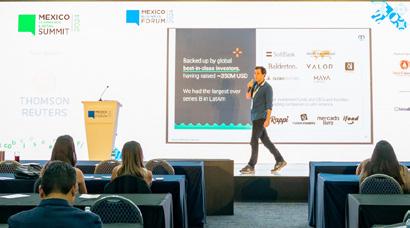
a t the core of Merama’s strategy lies a unique blend of investment and operational expertise. Merama’s approach involves making initial investments in promising brands across the region and then leveraging a team of experts to accelerate the ir growth.
a key emphasis for the company lies in sharing value creation with partner companies, fully integrating them into its ecosystem through call options or long-term earn-outs. Upon exercising or completing these, Merama assumes sole shareholder status, ensuring seamless integration into its global platform. “ o ur commitment to innovation has driven the development of products that resonate with Latin a merican consumers. f rom top-selling protein supplements to baby car seats and ice makers, our products have made a significant impact in the e-commerce landscape,” says Cruzat.
Bolstered by prominent global investors, Merama has secured approximately US$350 million, marking one of Latin
a merica’s largest Series B funding rounds. “We see tremendous opportunities for growth in the region. d espite being the third-largest economy globally, Latin a merica still exhibits low e-commerce
penetration compared to other regions. t his presents a compelling investment thesis, supported by robust growth trends and favorable market dynamics,” says Cruzat.
Consumers increasingly demand a seamless experience across online and physical channels, but many companies are struggling to balance these two highly different fields, leading to inconsistent customer experiences. f ailing to implement a consistent strategy across both e-commerce and physical stores may lead companies to fa ll behind.
t o achieve a successful transition, businesses should understand how e-commerce complements their physical presence, which will allow them to build a reliable omnichannel model, explains a lejandro García, CI o , Miniso. He also urges companies to consider the three pillars of digital transformation: processes, people, and te chnology.
Viewing the transition from an integral standpoint will allow companies to leverage everything they know from the physical world and transition into the digital one. “Knowing well the product or service being offered is crucial for selling it in e-commerce, because the process is not the same. Understanding the advantages and disadvantages in the digital world and knowing the digital customer, allows
businesses to provide a good customer experience,” says García.
a s consumers have greater access to information, retail stores must evolve beyond mere product displays to showcase the technology, design, and innovation behind them. Many brands are shifting toward showroom experiences, enabling consumers to thoroughly examine products before making online purchases.
a well-executed transition to the digital world requires a comprehensive strategy that focuses on the omnichannel model, thus providing a seamless experience to customers. this retail strategy should allow for the integration of all sales channels — physical stores, websites, apps, social media, and marketplaces— into one place, says Carolina a rreola, Global technology a lliances Manager, Zendesk.
“Zendesk’s annual report found that seven out of every 10 Mexican customers want to start a conversation through one channel and be able to move and finish it in another, which is why the omnichannel model is essential for transitioning to e-commerce,” says a rreola.

e-commerce could be particularly beneficial for small and medium-sized enterprises. this approach not only attracts a wider and more qualified customer base but also offers a rapid entry point for businesses seeking to penetrate the market swiftly.

“There
are three crucial things that make the evolution from physical retail to digital possible: having a clear customer journey, possessing a flexible deck stack, and owning the data”
García. Modern technological tools allow for fast inventory updates, provide tracking and control, manage orders, integrate with shipping companies, and deliver the best experience to the customer. Businesses should collect data but they should also know exactly why it is being collected, he adds.
Daniel Navas CEO| Mora Mora
d uring the customer’s journey, companies need to test different options to see which work better. But a key aspect that companies should ignore at their own peril is logistics, as the supply chain plays a key role in e-commerce. “It is important to engage with a logistics partner regarding inventory matters. technological aspects are fundamental for managing orders across conventional channels. Managing customer service and handling returns entail forging partnerships and specialized know-how,” says alexis Patjane, Ceo and founder, 99 minutos.
to streamline operations, it is key to avoid manual processes as much as possible, says
In Mexico, less than half of the country’s population has access to a digital account, hindering the financial inclusion efforts that industry players are striving to promote, according to Myriam Cosío, Chief e xternal a ffairs o fficer, Clip, speaking at the Mexico Business forum 2024. d espite advancements in technology such as a I, aPIs, and open finance, Mexico still lags in the penetration of digital payments.
Banks are increasingly leveraging artificial intelligence (a I) and cloud technologies across various sectors to optimize services,
omnichannel strategies enhance customer satisfaction by delivering a consistent experience across touchpoints, fostering loyalty, and expanding sales prospects, says a MV o . In Mexico, 80% of digital shoppers prioritize attributes associated with a comprehensive shopping experience when considering a website for purchases. Moreover, omnichannel approaches enable businesses to gather and analyze valuable data from multiple channels, facilitating informed decision-m aking and customization of customer interactions.
technology has enabled e-commerce retailers to switch among platforms and provide more online trust than in person purchases, says Lorena Montaño, Ceo and founder, Mundo Mondo. despite the advantages, companies face several challenges when simultaneously managing online and physical stores, including supply chain management, inventory control, and order fulfillment. Cloud-based tools with centralized data or “intelligent retail,” offer seamless integration of a I and machine learning tailored to companies’ processes.
introduce innovative offerings, and enhance customer experiences, as reported by deloitte. the abundance of structured and unstructured data sources empowers banks to deliver tailored services and insights by gaining a comprehensive understanding of customer interactions.
a decade ago, out of 4.5 million formal businesses and 7 million informal ones, only half a million accepted digital payments. However, due to technological advancements and regulatory reforms since 2014, the number has surged to 5 million,

with 55% facilitated by aggregators. While the penetration rate of digital payments in the country stands at 25%, it lags behind the 40-50% seen in other Latin american countries, according to Clip. this shift towards digital payments signifies a transformative focus on user-centric approaches within the industry, reducing reliance on cash.
technology serves as the transformative engine in finance, particularly open finance and open banking, which redefine how institutions communicate with customers and enable hyper-personalization of products, according to a lejandro Servín, Head of o pen Banking, BBVa Mexico.
t hanks to open finance, coupled with a I, data, and usage history can be leveraged to offer superior products, expedite access to credit, enhance financial management, and empower users with their finances.
“ for SM e s, there are a lot of advantages, as information can be extracted from sources like IMSS or other bank accounts, not necessarily those to which the loan was requested. With a risk model, credit can be granted, potentially life-changing for entrepreneurs and the country as a whole”, adde d Servín.
However, consumer trust still hinders the adoption of new technologies in finance. “Security and culture are the primary reasons,” says Jorge Cabrera, d irector of Individuals (B2C Banking & Payments), Mercado Pago. “It is essential
to demonstrate and build them through real-life cases with technology and customer service. In instances where individuals contact us due to fraud, there is still significant investment required in technology and customer care within the industry.”
a I applications are revolutionizing customer interactions in the financial industry by enabling algorithms to detect transactional patterns and anomalies, facilitating proactive fraud prevention, risk management, targeted marketing, credit assessment, and lending decisions. a I has the potential to enhance Mexico’s financial sector, as evidenced by the US$595 million in investments attracted between 2022 and 2023, with further growth anticipated. But a na Cristina GadalaMaria, Principal, Q ed Investors, says that financial institutions must have a robust data structure to ensure effective data acquisition and governance, guaranteeing the quality of a I g eneration.
f or users to trust these technologies enough to use them and provide their data and access to their financial information, full transparency is paramount. “the importance of empowering customers to feel in control of their data is what will allow users to engage,” says ana Carolina Blanco, deputy director of d ata and Information, BanBajío. She noted that regulators play a crucial role in structuring security measures to facilitate this trust-building process. By ensuring regulatory support and customer empowerment, the
potential for establishing robust trust in data usage practices will fulfill its potential.
While Mexico already has data protection regulations predating the f intech Law established in 2018, additional specificity regarding a PIs is necessary. t he current
law primarily addresses at Ms in Mexico’s financial sector, limiting the offering of tailored products that meet consumer needs. However,experts agree risks associated with data sharing must be carefully managed, with individuals maintaining control over their data through transparent authorization processes.
artificial intelligence is already transforming the way people work, yet the current monetization model for a I makes widespread adoption among companies unfeasible. In this context, H2o.ai proposes a Big aI model with generative capabilities to harness the potential profitability for companies.
“a I-assisted work is both the present and future for companies. failure to adapt could result in imminent job loss because we are not offering anything new,” explained favio Vázquez, Senior d ata Scientist for Latin america, H2o.ai.
a ccording to Vázquez, interest in a I technology has surged exponentially every 24 months, as evidenced by the number of articles published on the subject in the a rchive platform. He notes that a I technology has already surpassed humans in many tasks and is increasingly closer to understanding human thought and analysis. However, the challenge lies in implementation.

“Companies have been hesitant to adopt artificial intelligence due to the time, complexity, and exponential nature of the process, coupled with a lack of success,” Vázquez elaborated.
t he main barriers to adoption include the high cost of investment required for experimentation. d espite its potential, implementing aI does not always guarantee profitability. Challenges include dealing with niche markets, low model accuracy, lengthy time for market use, high hardware costs, and the fact that the human brain still excels in areas where aI falls short.
“We conducted a study and found that if a client had opted for any other platform with a 6-month experimentation period, they would have spent 53 million tokens, equivalent to over US$1 million in o pen a I. Just for experimentation,” Vázquez emphasized.
He further suggests that the current system is not scalable and proposes to globally change the generative model through three pillars: f irstly, enabling the use of a I without token cost to prevent the dilution of benefits obtained from its usage. Secondly, developing new roles within companies where generative a I guided by workers is employed. a nd thirdly, fostering creative development and experimentation with a I usage.
“a I-assisted work is not just the future but already a reality for many companies. Individuals will acquire adjacent skills, enabling them to perform a variety of tasks. failure to innovate could lead to job loss and stagnation,” Vázquez emphasized.
according to H2o.ai’s proposal, the optimal approach for companies is not to equip each worker with aI but to cultivate workers capable of integrating the human element
and artificial intelligence. t his approach aims to automate tasks efficiently, thereby enhancing productivity and boosting company profitability.
a s fintech companies and traditional banking institutions embrace new technology for digital transformation, the integration of artificial intelligence (aI) into their operations stands to revolutionize the industry. Many job roles can be complemented or enhanced by this technology, yet there will always be internal resistance due to fears. the focus must be on how companies are specializing and preparing for change, said Patricio d iez de Bonilla, General d irector, Banco Compartamos, during the Mexico Business forum 2024.
a I holds the promise of expediting loan assessments, personalizing services, and providing meticulous customer attention for B2B services, thereby reshaping the financial landscape. Institutions must navigate a diverse array of considerations, from protecting their interests and anticipating customer behavior to fostering internal cultural shifts. While a I has demonstrated its ability to expedite processes, such as determining SMe credit eligibility in a mere seven minutes, realizing a return on investment requires not just technological implementation but also organizational adaptation, according to a rmando Herrera, General Manager of financial Products, Konfío.
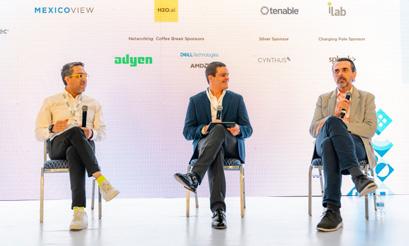
the most tangible results of aI have been internal thus far, but its impact is prominently visible in customer interactions, where prioritizing customer needs is encouraged. SMes generate three out of every four jobs, thus it is crucial for us as a financial institution to provide them with value in terms of predicting their needs, such as cash flow, according to Konfío data.
“We are exploring how to utilize the same client information, organized with a I, to make it more digestible and accessible for the clients themselves. However, challenges such as the lack of digitalization in SM e s due to limited resources and resistance to new technology implementation among established companies pose hurdles for the industry”, adds Herrera.
In fintech B2B aI implementation, companies prioritize efficiency to slash operational costs within their highly digital environments, ultimately offering credit at a fraction of traditional bank rates. “When there is something impacting all layers of the company, it is imperative to review the business model, ascertain its purpose, facilitating decisionmaking. the business model fosters agility for those in need of credit. Many clients are denied credit due to lack of history, yet aI can leverage alternative data to provide what the client requires. aI enhances the connection with the customer,” said Herrera.
t his approach not only enhances accessibility and affordability of financial services but also ensures competitive interest rates while maintaining profitability. Leveraging advanced digital infrastructure, companies deliver personalized financial solutions tailored to individual entrepreneurs’ needs and circumstances, fostering client satisfaction and risk m itigation.
t he implementation integrates a decision engine powered by a I, incorporating risk-management modules that utilize alternative data for swift and accurate lending decisions. t his fully automated process operates at a low cost, boosting efficiency and accessibility for clients, which is the most important part, as noted by d aniel Garbuglio, Senior Sales Vice President, a mericas , H2 o .ai.
“With hyper-segmentation, the customer journey relies on the collaboration of many individuals within a company, not just one. the user is paramount, and it is tempting for technology to bridge those gaps. However, it is crucial to ascertain whether that’s the optimal deployment of technology and identify where resources can be best applied to enhance the customer experience,” said Garbuglio.
Mexico’s private capital landscape is experiencing a surge in optimism and opportunity, fueled by its strategic position as a key partner to the United States and the momentum surrounding nearshoring initiatives. In a recent address, Liliana r eyes, C eo of the Mexican a ssociation of Private equity and Venture Capital ( a M e XC a P), highlighted the favorable conditions for both domestic and international investment i n Mexico.

“Mexico’s position in international trade and nearshoring is garnering significant attention”
Liliana Reyes CEO | AMEXCAP
and suppliers, we cannot maximize this opportunity,” r eyes stated.
With over two decades of industry experience, a M e XC a P aims to catalyze industry growth in Mexico by expanding investment funds and resources to support enterprises across all sectors. Currently, aM e XC aP holds an accumulated capital of US$71 billion, with US$54 billion invested and US$1.3 billion available for further i nvestment.
“ o ur partners, both domestic and international, see Mexico as a promising investment destination,” noted r eyes. “With 80 capital funds, 40 advisory firms, 770 investment vehicles raised, and 481 active vehicles, our focus remains on innovation, disruptive models, and cuttingedge prop ositions.”
“ t his is attributed to strong international trade partnerships and the country’s privileged geographical location, which sets it apart within th e region.”
Private equity investments, comprising a consortium of investor partners acquiring stakes in non-publicly traded companies, play a vital role in fostering job creation, professionalization, access to new investors and financing sources, and enhancing market reputation for invested enterprises.
r eyes emphasized the urgent need for capital infusion into infrastructure, energy, and sustainability sectors to fully capitalize on the current opportunities. “Without adequate capital for companies
t he organization’s objectives include strengthening relationships with institutional investors, increasing transaction frequency, engaging with regulatory authorities to enhance industry competitiveness, promoting industry awareness domestically and internationally, and generating statistical data and relevant industry studies.
a healthy venture capital ecosystem relies on robust partnerships with pension funds, multilateral banks, and other stakeholders to ensure sustained growth. Private equity funds aim to facilitate more transactions and provide alternative financing sources to bolster enterprise growth, underscoring the
importance of government collaboration to instill client confidence.
Key players in private equity funds, including investors (LPs) and fund managers (GPs), actively engage in corporate governance and guide funded companies towards growth. a M e XC a P represents a diverse array of investment types, including entrepreneurial capital, private credit, real estate, corporate, growth capital, infrastructure, and energy, encompassing over 1,600 companies and 500 projects.
In Mexico, private equity strategies have gained traction, attracting over US$9.4 billion in investments in recent years through more than 2,000 investment transactions, with approximately US$220 million available for further i nvestment.
“ f or the first time, alongside Mexican funds, we witnessed the arrival of international investment funds in 2021, fostering the emergence of unicorn companies and supporting ongoing business growth,” r eyes hi ghlighted.
Mexico’s private equity industry stands as the second-largest in Latin a merica, surpassing combined investments in
Colombia, a rgentina, and Chile. With an increasing number of experienced fund managers overseeing significant investments, Mexico presents a compelling opportunity for entrepreneurs seeking strategic partnerships and financia l backing.
a M e XC a P remains proactive through industry events, national and international summits, collaborative initiatives with Latin a merican associations, and educational programs tailored to entrepreneurs’ needs.
a s entrepreneurs navigate the investment landscape, access to expert guidance and specialized training programs becomes essential for informed decision-making. today, entrepreneurs have a plethora of fund options to choose from, tailored to their needs and experien ce levels.
In conclusion, Mexico’s venture capital ecosystem is poised for continued growth, driven by strong fundamentals, strategic partnerships, and a commitment to innovation. With supportive regulatory frameworks and a diverse pool of investors, Mexico offers a conducive environment for entrepreneurial success and sustainable economic development.
a s the venture capital (VC) market shifts from overexcitement to a more cautious risk evaluation, startups are adjusting their strategies with a focus on achieving profitability. t his is increasingly relevant as both sides seek alignment beyond the capital, especially regarding values and overall objectives.
a ccording to reports from SlingHub and Itaú BB a , Latin a merican startups raised over US$5.75 billion in 885 funding rounds in 2023, marking a 34% decrease compared to 2022. Brazil led in total investment with 54%, followed by Mexico with 25% and Colombia with 11%. In terms of the number of rounds, Brazil also led with 55%, followed by Mexico at 13% and Chile at 10%.
In comparison to 2021, when Latin american startups raised over US$20 billion through 952 VC agreements, the gap has widened. a ccess to VC has been restricted since 2021 due to higher interest rates and rising inflation. “a s a fund, when valuations start to explode, you do not want to miss out on the next Uber or similar opportunity,” says ana Carolina Mexia, Co- founding Partner, NIdo Ventures.
andrea de la Garza, Ceo and founder, Pilou, describes facing a challenging environment as an entrepreneur. She highlighted intense competition from other startups and a landscape where some had remarkably high valuations. a ndrea noted a shift in the VC’s focus, from the requirement for

startups to showcase exponential growth to the imperative of demonstrating profitability.
e xperts anticipate 2024 to be a market correction year, with VC activity expected to return to pre-pandemic levels in terms of volume and new investment. However, under the new reality, rounds are expected to be smaller and with less abundant capital. “ fortunately, we never stopped investing. I believe this is not a burst bubble, but rather a new normal for VC,” says Cecilia ezquerro, Portfolio director, 500 Global.
In this new normal, VCs will exercise greater caution and prefer to invest in more mature startups. this shift in focus means that capital will flow toward companies that are ready to receive financing, requiring robustness and strong projections from businesses, as well as demonstrating strong value embracement. “as corporate investors, we do not make investments unless there is at least a partial fit with Bimbo’s vision. However, we acknowledge that evaluating values is easier for us than for a VC fund,” adds Constantino Matouk, Vice President, Global Bimbo Ventures, Grupo Bimbo.
experts emphasize that the events of 2023 demonstrated that achieving a high valuation does not guarantee success. Consequently, VCs are placing greater emphasis on startups committed to sustainable growth and efficient operations, rather than those solely focused on raising capital through multiple rounds of investment. “the adjustment was necessary, irrational valuations did not benefit anyone, neither startups nor VCs. We are
now noticing that entrepreneurs are also less concerned about valuation, contrary to what happened previously, when they were experts in justifying extremely high valuations,” Matouk adds.
While the VC market landscape has evolved since 2021, experts believe there is still a window of opportunity, particularly with the increasing adoption of technology in Latin america. e xperts note that the Latin american startup profile also plays a positive role, as entrepreneurs are better prepared to work with fewer tools. “as Latin americans, we know how to make things happen with the money and limitations we have. Just like founders of startups, we must know how to leverage these skills that our environment has helped us develop,” ezquerro notes.
d espite the altered economic outlook compared to the times of abundant capital, experts believe that a window of opportunity still exists for startups in 2024. In this context, experts suggest that both startups and investors should be responsible. Startups should focus on people, rather than just thinking about accelerated growth, as noted by de la Garza. “VC funds should be more than just funds, they can provide support to entrepreneurs and add much more than just capital. this is not a one-sided relationship where the fund provides money and forgets about the company and vice versa. on the contrary, it is a shared journey to achieve the goals of all parties involved,” alvaro Vertiz, Partner and Mexico Country Head, dentons Global advisors, says.
a s businesses increasingly migrate their operations to the cloud, securing these environments becomes paramount to safeguarding sensitive data and mitigating potential threats. addressing this critical need, a lejandro d utto, d irector of Security e ngineering for Latin a merica and the Caribbean, tenable, sheds light on the importance of adopting a proactive approach to cloud security, emphasizing the need for robust solutions capable of defending against sophisticated cyber threats. “With cloud-native applications becoming the backbone of modern businesses, protecting these assets requires a comprehensive understanding of the unique security challenges they pose.”
o ne of d utto’s key highlights is the introduction of CN a PP, a cuttingedge security platform designed to safeguard cloud-native applications and infrastructure. CNaPP offers organizations a holistic approach to cloud security, combining advanced threat detection capabilities with real-time monitoring and response mechanisms. By leveraging machine learning and behavioral analytics, CNaPP empowers organizations to detect

and mitigate security threats proactively, minimizing the risk of data breaches and unauthorized access.
a key element in cybersecurity is how to protect a growing surface as we move into cloud. We are used to dealing with on-premises security, even when we take workloads to the cloud, but with cloudnative applications, identity management becomes a challenge, d utto says. “ t he points through which they (criminals) can access are constantly growing. every minute 50,000 new hosts and domain names are created on the Internet. With 50,000 attack accesses per minute, added to the number of devices we have, it becomes overwhelming,” he explains.
dutto emphasizes the critical role of identity management in securing the extended attack surface created by the proliferation of cloud services and Iot devices. a s organizations embrace digital transformation initiatives, managing identities and access privileges becomes increasingly complex. Identity management solutions play a crucial role in ensuring that only authorized users have access to sensitive data and resources, thereby reducing the risk of insider threats and credential-based attacks.
d utto underscores the importance of collaboration between security teams and It departments in implementing effective security measures. By fostering a culture of security awareness and investing in the right technologies, organizations can enhance their resilience against evolving cyber threats and maintain the integrity of their cloud environments.
“ t he modern attack surface is highly dynamic. We are in a network that behaves, at the end of the day, like a living being. Its characteristics change day by day, minute by minute,” says d utto, adding that in organizations, we have production, networks, and local infrastructure, which
in the past were three separate things. Nowadays, they are increasingly a single entity.
d utto highlighted the growing complexity in cloud security, pointing out the need for a comprehensive solution that addresses various aspects such as infrastructure-ascode management, regulatory compliance, vulnerability analysis, and identity management.
CN a PP and Identity Management for the extended attack Surface provided valuable insights into the evolving cybersecurity landscape and the importance of adopting proactive measures to protect cloud-native applications. a s organizations continue to embrace cloud technologies, prioritizing security and implementing robust security solutions will be essential in safeguarding critical assets and maintaining trust in the digital age, highlights dutto.
Mexican businesses are increasingly relying on the cloud to store data to analyze customer behavior, optimize their operations, and improve their market strategies. However, this accumulation of data has also increased their vulnerability to cyberattacks. In these circumstances, the combination of cloud security and a I has become an inflection point in the way organizations address cybersecurity challenges and protect their digit al assets.
aI’s ability to analyze large volumes of data in real time, detect suspicious patterns, and automate threat responses has made it easier for companies to address risks in the cloud. t his convergence of technologies enables businesses to anticipate threats, minimize response times, and ensure the security and continuity of their operations in an increasingly complex and challenging digital environment.
“a I is an ally but also an enemy. o ne must know how to use it and be aware that it
is not about using it just for the sake of using it. It can monitor user behaviors and suggest defense strategies, but it lacks intention and can block something that is not a threat,” says Chava Valades, a ssociate d irector Cybersecurity d efense o ps, a s traZeneca.
Cloud security has become a critical issue in Mexico’s business landscape, where the amount of data stored in the cloud continues to grow exponentially. t his accumulation of data has also increased the vulnerability of companies and users to cyberattacks, such as malware, phishing, and denial of service ( dd oS) attacks. t he complexity and dynamism of this environment requires constant attention to preserve data integrity and ensure the continuity of business o perations.
“We are migrating to the cloud when we still do not have a good grasp of it and lack the proper tools. t he cloud is a relatively new technology, but in the cloud,

protection is not based on equipment or organization, hence prioritizing is important. If you go to the cloud, there will always be a vulnerability,” says Valades. t hus, he urges companies to research and use a I as an ally but continue to rely on a human decisi on maker.
t he implementation of a I solutions in cloud security is also not without its challenges. Mexican organizations may face issues such as poor data quality and false positive management, all while continuously having to adapt a I systems to new threats. It is also critical to coordinate security teams while complying with local privacy and data protection regulations. a I is expected to evolve to adapt to new threats and challenges that arise in this dynamic and constantly changing env ironment.
“AI
in cybersecurity is a strategic ally in facing a variety of attacks. Without AI to protect us, it will be difficult to confront them. But we must be careful not to abuse AI. Analysis and counterbalance are necessary, which can be provided by a human analyst. Threat hunting aims for the earliest possible prediction to lead to containment”
 Asgard León Chief Information Security Officer | TV Aztec
Asgard León Chief Information Security Officer | TV Aztec
sector, industry, or country, thereby preventing potential threats, explains d avid Varela, Cybersecurity d irec tor, Izzi.
a I can also improve the detection speed by monitoring internal and external information sources and swiftly correlating this information to detect unusual activities, minimizing potential repercussions, says Valades.
to successfully use a I, “one has to test the limits and see how far one can go. What the industry should do is share more; otherwise, the information becomes siloed. With deeper collaboration mechanisms, one could anticipate any risk and learning would be easier. Keeping updated, taking care, and anticipating are essential to being ready,” says e duardo Verboonen, Co-President, Hospitales M aC.
t here are now many technologies in the market that use a I to detect threats. But if the information presented by a I is not tested and subjected to challenging environments, it is not possible to know if one has the right solution, says León. It is necessary to continuously put the system to the test with structured processes so that the protection layers are appropriate. If there is no way to ground the system, a ro I will be difficult to achieve, he adds.
Numerous entities such as government bodies, medical facilities, and banks have fallen victim to cyber assaults, reports e LS e VI er . However, the advent of a I has sparked a surge in software innovation. a I-driven tools are streamlining processes like forecasting, data retrieval, and content generation, presenting new avenues for efficiency and security en hancement.
With high levels of cybersecurity maturity, teams can take compromise indicators, place them on platforms, and transition from reactive to preventive security measures, employing cyber patrols to identify what is happening within the
t here is a gray area in what to block and allow in the traditional approach of cybersecurity strategies, as everything keeps changing, says Jonny López, Consulting Sales e ngineer, Cradlepoint. However, protecting and informing the user should always be a priority. “ t he weakest link in the chain is the user; they need to be informed with awareness campaigns and training on how to respond to threats. t he organization also needs to react timely and early,” s ays López.
Users should be trained to prevent information leakage. Knowing how the user behaves is an important control point to prevent attacks, says León. “Prioritization is necessary — not all data is sensitive.
Identifying critical information assets and regulating its use helps organizations. Governance must exist, as should rules and regulations to limit where a I should be,” says Léon.
t he speed at which a I evolves and the adoption of user platforms create a security gap, says López. this gap can be mitigated by using a I itself to detect patterns and counteract attacks, but it requires context,
controls, measures, and policies to ensure those tools are not turned against the business.
the implementation of aI in cybersecurity requires a comprehensive strategy that considers all scenarios. Communication across the entire company is also crucial in implementing these tools, and should be used to anticipate and prevent threats, while also helping employees navigate attacks.
the aftermath of the pandemic has spurred a swift shift towards digitalization across various sectors, especially in finance. José Barrera, digital & e-Commerce Sr. Manager, Natura & avon, emphasized the need for intuitive and innovative solutions to drive financial inclusion and reduce reliance on cash during the Mexico Business forum 2024.
analicia García, VP of retail & Commerce, d igital Partners & f intech, Mastercard Mexico, highlighted that 45% of global spending now occurs in e-commerce, with contactless payments constituting 65% of all physical transactions. However, despite these advancements, Mexico continues to grapple with the widespread use of cash, with over 71% of point-of-sale transactions still cash-based.
García stressed the importance of enabling seamless transactions, even when exceeding budget limits, and emphasized the need for secure digital payment solutions. Measures like promoting 3 d S and tokenization are essential to build customer trust and mitigate fr aud risks.

d espite progress in electronic payment adoption and the proliferation of mobile wallets, challenges persist, including the high costs associated with card issuance and the need to innovate payment methods beyond traditional approaches. Héctor Meza, Country Manager, Ingenico, highlighted the potential of biometric authentication methods like vein recognition (Palm Pay) to revolutionize payment experiences.
While there is growing momentum towards a cashless society, fueled by environmental benefits and regulatory support, Sebastián de Lara, Ceo, fintech Mexico, acknowledged that traditional cash transactions are likely to coexist with digital payments. open banking initiatives are driving customization and streamlining payment processes through aPIs, yet security concerns remain a hurdle to widespread adoption.
e stephany Ley, r etail Banking Corporate d irector, Grupo Coppel, emphasized the importance of transparency and innovation in building customer trust. Ley highlighted the need for convenient and secure payment methods in e-commerce, such as fingerprint identification for credit assessment.
t he convergence of anti-fraud measures with user-friendly experiences is crucial for the successful adoption of digital payment technologies. Now is an opportune moment to leverage technological advancements for real-time data exploitation and personalized customer experiences, although their full potential is yet to be realized in Mexico.












